1 Volume I, The Early Years
Vladimir Marinich
TABLE OF CONTENTS
Preface
Even Before the Beginning
The Beginning
Getting Into the Systems Approach
We Were Small, but Burgeoning
The Change Agent
Programs, Nature Walks, and Growth
Accreditation
The College and the Evaluation System Grow
MBO’s and All That Stuff
There Was More Than MBO’s
1976 Started Out Well
Enter the Press
Changes in the Late ‘70’s
’78 Rocked!
And So Did ’79
Nearing the End…of the Beginning
Smith’s Legacy
Appendix I Three-dimensional Rendering of HCC’s First Building
Appendix II HCC Staff Who Went on to Presidencies/Chancellorships
Appendix III Chronology of Public High Schools in Howard County
Appendix IV Three-dimensional Rendering of the Nursing Building
Appendix V Proposed Organization Chart, 1978
Appendix VI HCC Full- and Part-Time Enrollments, 1970 – 1980
Endnotes
PREFACE
This history of Howard Community College was made possible by a sabbatical leave of one semester in the spring of 2006. The prior year I was given time to work on the HCC archives and this allowed me to research and gain even more knowledge of HCC’s past, but in doing this, the more I found out, the more there was still to find out; so, the problem was not in having enough material, it was condensing what seemed to be, on occasion, too much material.
I got to work on archival materials in the prior year, but I wasn’t the first. My colleague and friend, Larry Madaras, began the process. In his last semester at HCC, I worked with him on some parts of archival materials, and when he retired in December 2004, I took over the project; but I didn’t do it alone. There were several other dear colleagues who were part, and partners, in what we did in 2005. Four major areas of activity were seen as necessary; one was the collection and organization of official college materials – all the catalogs going back to year 1, student handbooks, annual reports, bylaws, policy documents, Board Minutes, student newspapers, enrollment reports, course schedules, you name it! There was no central repository for these materials, so HCC established an archive and hired Norah Burns to do much of this work. I gladly assisted her where I could, and continue to do so. A second area was regional and local newspapers. Over the past year we have been going through all the newspaper articles and clippings that had been saved by the college to determine what was salvageable. While these newspaper articles provide a wealth of material, unfortunately some of them have deteriorated to where they cannot be scanned or photographed. In some cases there were multiple copies of the same article and we had to choose the copy that was physically the best. And sometimes the best copy was not all that good.
A third source of information was the HCC documents of various kinds; memos, letters, minutes of various committee meetings, and various other college publications that did not always fit into any particular category, of which there were quite a few, and many of these publications were not produced on a continuing basis and often enough the name of the publication changed. Fortunately, a lot of this information has survived, and that is good. However, in some instances there are gaps. So, for example, in this narrative I refer to the enrollments of the summer session, 1975, as the first mention of HCC’s summer classes. It is not clear whether previous summers’ enrollments have been lost, or whether they have not yet come to the attention of the archives. In other words, we do not have previous summers’ data.
The fourth area that needed serious attention was photographs. Over the thirty six years of the college’s existence there have been tens of thousands of photographs taken of various locations, buildings, classrooms, events, and individuals (faculty, staff, students, community residents, leaders, and visiting dignitaries). It was important to identify as many of these as possible and to categorize them in terms of when the picture was taken, who was in it, what was the location and event, and selecting the best copy of the picture, where multiple shots were taken, to keep and digitize. The approach was to have a team do this. It could never have happened without Quent Kardos, the head of HCC’s A/V Department. His ability and skills were indispensable. Norah Burns recorded all the information as we reviewed one photo at a time and set up the data base. Dr. Peggy Mohler of the Grants Office was invaluable for her knowledge of the college and the community. These are the “superheroes.” I am on the team as the “college historian” who can often tie together individuals, events, and locations of a photo to give it greater clarity in identifying it. From time to time other colleagues joined our review sessions to help with identifying photos. Over the past year and a half the team has reviewed approximately 17,000 photos and identified about 1,900, and there are probably just as many, if not more, still to review.
This brings me to a fifth source of information; oral communication. Larry Madaras conducted a number of interviews that were recorded and transcribed. They are part of the historic database, as are the ones that I have done. I have, however, also gotten comments from colleagues in informal settings about various past people and events. These comments came from folks who are part of the history of HCC, some of whom are still here, and their comments are sincere views of past events as they experienced or perceived them. In some instances the same events were seen completely differently by two different people. I have heard these words and terms used about past events: “watershed moment,” “defining moment,” and “crisis.” On the other hand the same events were seen by others as “unimportant,” and “what are they talking about?” While this kind of information was interesting, I could only use it if there was a clear pattern in its understanding by more than just one or two people. Consequently, the major source of information in trying to present the history of HCC is documentary evidence that includes memos, minutes, reports, samples of faculty work, newspaper articles, and planned interviews for anecdotal information.
One of the challenges in developing this history was that the archives were, and still are, in the process of development and organization. As a result, much of the information that I was able to glean was not from organized or catalogued sources. This is not an attack on the archival project, since I have been assisting in that area, but simply recognition that this history project was being developed as the archives were being developed. Consequently, as I was writing the history I was finding more things that needed to be included, but I eventually had to stop adding newly discovered pieces of information, otherwise the research would go on forever and this document would not get produced.
All historical writing is interpretation and narrative. This means that historical writing is the telling of a story and, in doing so, one uses the best, most thorough, and most accessible information that is available. I think that I have described the information that I gathered, and I have tried to exercise care in presenting a balanced story of HCC. This is not the history of the community college movement with HCC as an example of such a national movement. Rather, this is the story of one school’s origins and development as experienced by the community, students, and staff of the college. This brings me to the final point about this project. For those of you who like to read the last chapter of a book to see how it ends, and prefer not to deal with everything in the middle, I will tell you up front how this history project ends. It is the story of an ongoing success that started over 40 years ago.
There are quite a few folks who deserve my thanks and appreciation. Larry Madaras started the ball rolling and when he knew that he would be retiring he gave me a lot of the materials that he had collected and developed (and if you know Larry, the word “collected” is an understatement). He was also very supportive of me continuing this work. Dr. Mary Ellen Duncan, HCC’s President, encouraged me and, just by being herself, she showed me that she had faith in my being able to accomplish this project. Our Academic Vice President, Prof. Ronald Roberson, gave me time to work on the archives, and this was really an important foundation for getting HCC’s history written. I needed time to put the information together and to write the history, so I applied for a sabbatical leave. The Chair of the Social Sciences Division, Dr. Jerrold Casway, supported my application and wrote a very strong recommendation on my behalf. I appreciate this support very much. My getting a sabbatical leave was great for me, but it put quite a burden on Jerry’s shoulders. He had to staff the courses that I normally teach, and as anyone who has had to locate and hire adjunct faculty knows, this is no easy chore. The Sabbatical Leave Committee recommended my leave and sent it up through channels. The Board of Trustees approved. So, to all of you, I extend my appreciation and gratitude.
As the manuscript progressed, I asked Dr. Alfred Smith, the first president of HCC to look over the forty eight pages that I had written up to that time. He responded and made some comments and observations that were helpful. As the manuscript came to an end I wrote to Dr. Smith asking if he would be willing to review the completed manuscript; however, I have not heard from him as yet.
Joetta Cramm, who I believe could rightly be considered as Howard County’s historian, reviewed the work and responded. I appreciate her several observations and questions. Larry Madaras also got the completed manuscript and offered a number of helpful observations.
I marvel at the magic that my colleague Professor Dave Hinton can work with computer images. He produced the three-dimensional renderings of the first building and of the Nursing Building. I thank him for his generosity of time and effort.
I have to mention Norah Burns and Quent Kardos again. To use an expression that we hear our younger students employ all too often, Norah’s and Quent’s competence, professionalism, dedication, and support has been “totally awesome.”
My colleague, Dawn Malmberg, made this HCC History look good by doing all those things that make this document look professional. Her skills never cease to amaze me. Thanks, Dawn!
My colleague at HCC, and my wife, Barbara Livieratos, read this material and gave me suggestions and ideas for accuracy of expression, general layout, editing, and gave me lots of encouragement and constructive criticism. Much thanks to you, Barbara.
EVEN BEFORE THE BEGINNING
Howard Community College’s history, growth, and success are obviously linked to the growth of Howard County and to the development and growth of Columbia. In October 1963, The Rouse Company announced that it had acquired some 14,000 acres in Howard County for the purpose of building a planned city.1
By May 1965, the planning of Columbia had progressed to the point that on May 28-29 a meeting was held of the “College Advisory Group for Columbia” in the Village of Cross Keys.2 Some time before this meeting, perhaps in 1964, James Rouse had already been thinking about “educational facilities over and above the senior year in high school.”3 Rouse wondered about the type of post-secondary education in Columbia. “Should we have a two-year junior college, or a four-year liberal arts college? Or do we move toward a trimester system that would make it possible for a student to receive a BA degree in three years? Another possibility might be to encourage the establishment of a public junior college in Columbia, and then add a private ‘senior college’ for junior and senior year on a trimester system.”4 Rouse continued by mentioning vocational education, adult education, and life-long learning as major elements of “the fullest possible development of an individual.”5
While this was going on, the Howard County Board of Commissioners (this was several years prior to the charter that created a County Council) and the county’s Board of Education began to think seriously about a community college. The majority of Howard County college-age students who went on to a community college went to Catonsville Community College. Dr. Edward Cochran, who was on the Howard County Board of Education in the 1960’s, estimates that this majority was about 90%.6 The two problems that Howard County faced with this arrangement was that the state and county were picking up the equivalent of out-of-county fees, and Catonsville Community College would contact Howard County each year “about whether or not they could take the students for the following year.”7 This was not the most stable of conditions to operate under year after year; so, in 1965 a committee was formed to look into the possibility of a community college in Howard County.
In October 1965, after meetings with the Maryland State Department of Education, the Board of Education “passed a resolution indicating intention to form a community college and move forward with that project.”8 The original thinking was to open the college in 1967 with classes to be held in one of the existing high schools with late afternoon and evening classes.9 The County Commissioners authorized the Board of Education to be the college’s Board of Trustees, and on March 18, 1966, Howard Community College received authorization by the Howard County Commissioners. Three days later the State of Maryland approved the establishment of the college. Howard Community College would be the fourteenth community college in Maryland.
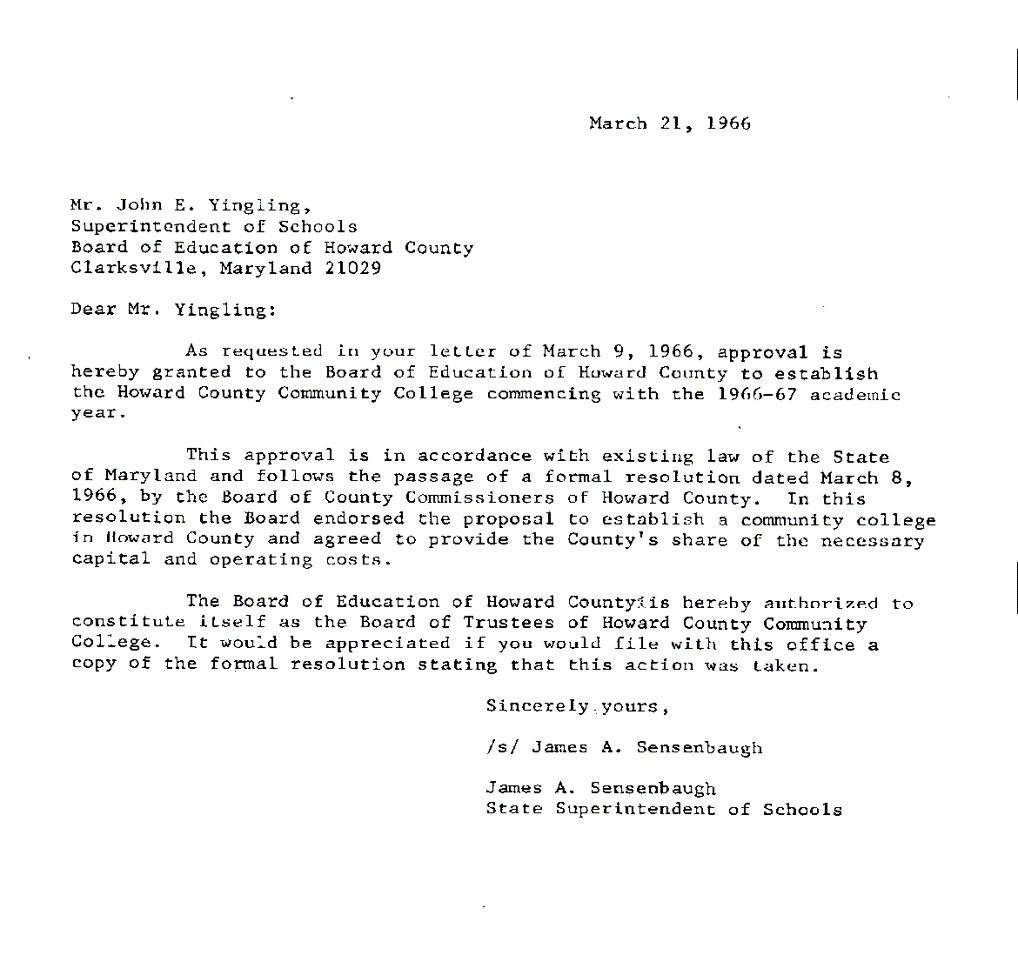
By 1966 Howard County had evolved from being primarily an agricultural county to one that was suburban, and exurban the farther out that one went. The western part of the county was still very much agricultural. Route 29 was a two-lane road and Route 40 had none of the sprawl of strip shopping centers, gas stations, or fast-food places, and the closest McDonald’s was inside the Baltimore city line. The county, as already mentioned, was run by Commissioners, and there were 4 public high schools; Atholton, Glenelg, Howard, and Mt. Hebron. There was also one private nonsectarian school, Glenelg Country School that opened in 1954, although the high school portion of the school did not begin operations until 1985 and did not see its first high school graduation until 1989. In 1966 the population of the county was about 50,000, and Ellicott City was the historic county seat. In other areas of American society, the book world saw the publication of Truman Capote’s “In Cold Blood,” and American theatre was enjoying “Cabaret.” Walt Disney and Montgomery Clift both died in ’66, and entertainers Halle Berry, Salma Hayek, and Chris Rock were born.
The ultimate location of the site for the future community college was not without discussion and debate. Cochran recalls, “the Rouse Company had a particular site to recommend to the Board, and the other folks who thought it should be in Ellicott City or whatever did not have specific sites. They just had a feeling that it ought to be somewhere else.”10 The Rouse Company’s recommended site may not originally have been where the college now stands. Again, Cochran also recalls that the Rouse Company had other plans for the frontage on Little Patuxent Parkway; The Rouse Company wanted the front of the college, along Little Patuxent Parkway, to be reserved for commercial properties. The Board refused to agree to this, and the Rouse Company eventually relented.11
The site for the college was finally accepted and in June 1966 the land was purchased for $300,000. Thus, the myth that the college got the land for $5 is just that, a myth or, in today’s parlance, an urban legend. The breakdown of the cost was that the county and federal funds would each pay 25%, and the state would pick up the rest. There was also some discussion that the location of the college in this area near Columbia’s future downtown would place it “adjacent to the ‘future private college’ expected to be built in Columbia.”12
The projected opening of the college for 1967, with classes in high schools was postponed when the Board of Trustees was informed in late 1966 that Catonsville Community College would be able to continue to take Howard County’s students. As a result, the Board decided to plan for a campus and an opening date of Fall 1970.
Early in 1967 Dr. Joseph Hankin, President of Harford Community College, was hired as a consultant to help the Board with its planning of the college. The Board requested $1,630,000 from the state and $1,450,000 as a bond issue. These funds were used for the construction of the first building of the college.
The first phase of the college’s construction was to have a main building and a fully equipped gymnasium; however, the architects for the college, Perkins and Will, a Washington based organization, reported to the Board of Trustees that “preliminary studies of the site and the most recent figures available on site preparation costs in the area indicate that the original estimates for site work were low. In order to follow the Board’s instructions to stay within the approved budget, the architects feel that it will be necessary to consider omitting the original plans for a fully equipped gymnasium.”13 The ultimate plan, though, was that the first building was to be part of a future complex that would be developed over several years.
The Howard County Community College anticipates an enrollment of almost 1,800 students by 1975, at that date, an estimated $8,000,000 will have been spent on campus facilities, including a five-story, 75,000 volume library, and an auditorium with a seating capacity of 2,000.14
The memorable world event of 1969 was Neil Armstrong setting foot on the moon. On the national scene, Richard Nixon was into the first year of his presidency with his vice president, the former governor of Maryland, Spiro Agnew. At the movies, the film to see was “Butch Cassidy and the Sundance Kid.” Hollywood lost Judy Garland that year, and everyone was reading the blockbuster novel, “The Godfather.” That summer saw a lot of activity in Howard County and Columbia. A groundbreaking ceremony for the college was held during the week of June 22. That same week a groundbreaking ceremony was held for the first Interfaith Center to be built in the Village of Wilde Lake; The Rouse Company announced that it was moving their corporate headquarters from the Village of Cross Keys in Baltimore to Columbia, and would be housed in the new American Cities Building; and local residents protested the size of a Seven-Eleven store’s sign in Columbia to the Howard County Planning Board.15 Jim Rouse’s grandson, Edward Norton, was born. Norton grew up in Columbia, and would become a well known film actor.
Howard County was not the way it is today, and Columbia certainly was not either. Route’s 29 and 40 have already been mentioned. And the only movie theaters were the Westview Cinema and Edmondson Drive-In, which seemed very far away from Columbia. Of course Columbia in late 1969 and 1970 was quite small. The Villages of Wilde Lake, Oakland Mills, and Harper’s Choice existed, as did the Longfellow neighborhood. Swansfield was just being built. Sewell’s Orchard was just that – an orchard where one could go to pick and buy fruit and berries. And, as for the rest of the villages and neighborhoods of Columbia, they were still in planning stages or very early development.
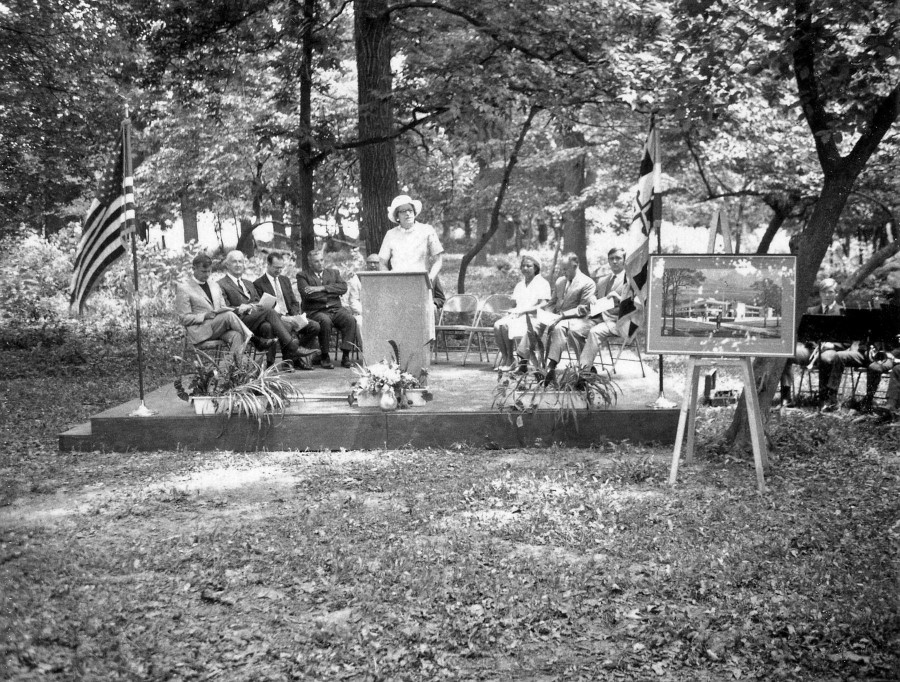
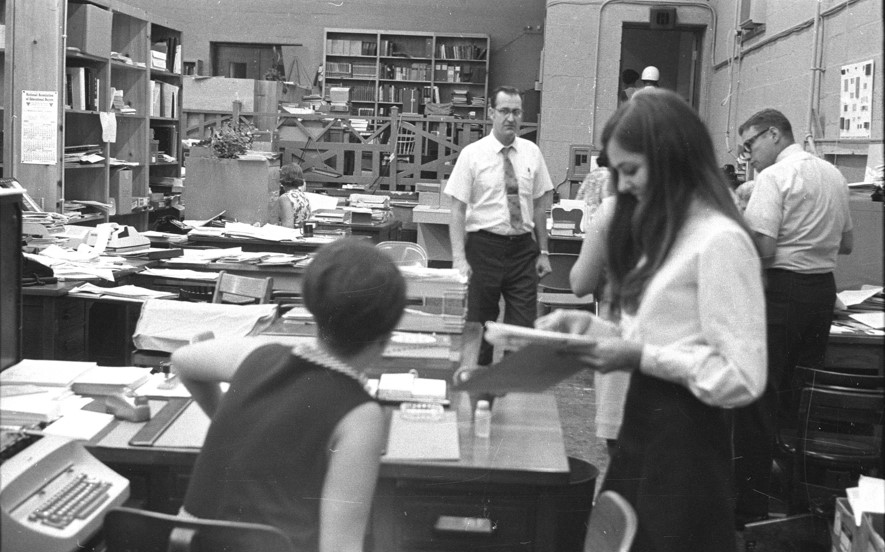
The president of the college was Alfred J. Smith, Jr. He had earned his M.A. from Columbia University, Ed.D. from Indiana University, and had most recently been at Corning Community College in New York, where he began as a faculty member teaching business courses, advanced to Chair of the Business Department, and was most recently the Academic Dean at Corning. Donald Forsythe, who had been the Dean of Continuing Education at Corning Community College, thus having been Smith’s colleague in New York, was hired by Smith to be the Dean of Faculty (a title that was to be changed a few years later to Dean of Instruction). The Dean of Community Service was Joseph DeSantis who had come from Niagara Community College. The Librarian was Mrs. Elizabeth Siggins, and the Director of Administration was Mr. Darrell Campbell. The offices of these first people were in the old gymnasium area of the Board building.
Smith, who had been hired in mid-1969, had more than his share of work to do between his start as president and the opening of the school that would happen just a little over a year later. The schedule and progress of construction had to be monitored, college policies had to be developed and approved by the Board, the entire educational program had to be established, which included admissions, records, financial aid, the transfer and career programs, courses, and the catalog and Fall 1970 schedule of classes had to be put together and published. While some of these things followed from Smith’s experience at Corning, and many responsibilities were delegated to the first cadre of administrators, this was still all a brand new experience for all. And, it has to be noted, not only was Smith the first president of the college, but this was also his first presidency. There was a lot of trailblazing to be done.
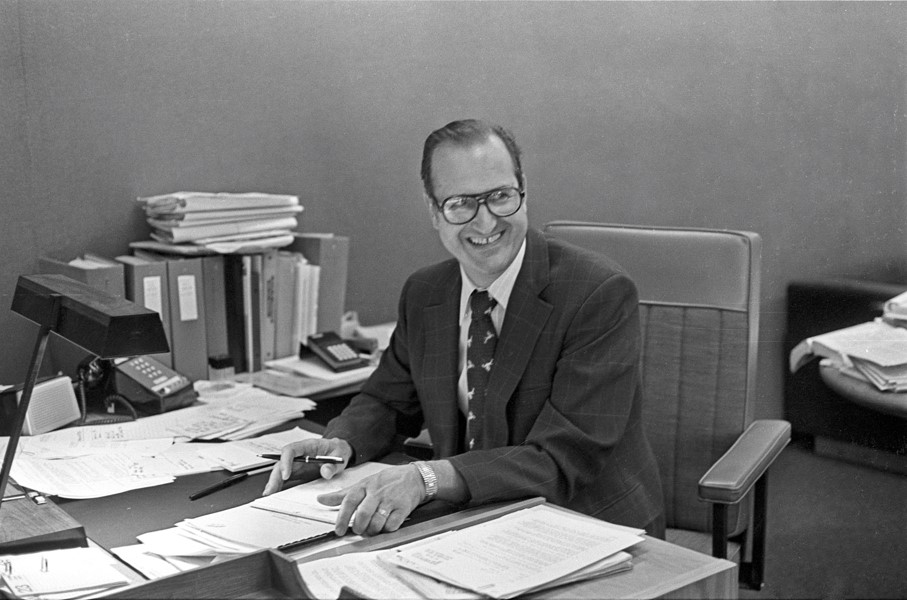
Not the least of Smith’s responsibilities was getting the county acquainted with the college that was to become a presence in the community within a year. This required him to meet with the county’s elected leaders, Columbia’s leaders, and any number of community, civic, social, educational, and business groups, and to give talks and presentations to these groups as well as at town meetings16 and to the county’s high schools.17 Not only that, but there were some Howard County residents who perceived the college more as a part of Columbia rather than a part of the county; so, explaining that away took some work. With all of Smith’s efforts and challenges, there was still Catonsville Community College that had been the draw for the county’s high school graduates. So, pitting a college that did not exist yet against an established one just across the county line was a formidable job of marketing and public relations.
Smith was a visionary then, and he continues to be so even today. In an interview for the college’s cable TV channel in 2005 Smith reiterated his philosophy that a true learning institution focuses on the student and this requires a school to take into account a student’s rate of learning and learning style. Consequently, such things as a college’s primary teaching approach of lecture and the establishing of fixed time limits for learning (i.e., semesters, quarters, etc.) are inconsistent with a true learning environment. But even back when he was hired and his views were known to the Board that employed him, some of his vision was met with a degree of caution and resistance within the county. Smith publicly promoted the concept of non-punitive grading, especially as it was demonstrated in the college not having an ”F” grade. He did not believe that students should be institutionally penalized for academic non-performance. Frederick K. Schoenbrodt, who was the founding Chairman of the college’s Board of Trustees, approved of the grading policy, but with the admonition that standards had to be maintained. The county’s Superintendent of Schools, M. Thomas Goedeke, flat out disagreed and argued that students had to be held responsible for their performance, and that failure was part of life and part of the real world.18 Goedeke’s comment, as quoted in the newspaper, requires some thought, since a year later Wilde Lake High School opened, under the principal, Dr. Jack Jenkins, and employed many of the same educational concepts as were promoted by Smith for HCC. Wilde Lake High School had individualized and self-paced learning, and some non-punitive grading. So, Goedeke’s comments, if quoted accurately, present difficulties. In any case, the Board supported Smith’s initiatives and, for fifteen years, the college did not have an “F” grade; rather, there were two non-punitive “X” grades. In addition, there was a “D” grade the first year, but it was removed the next year. The “F” grade replaced the “X” only in 1985, and the “D” returned in 1992.
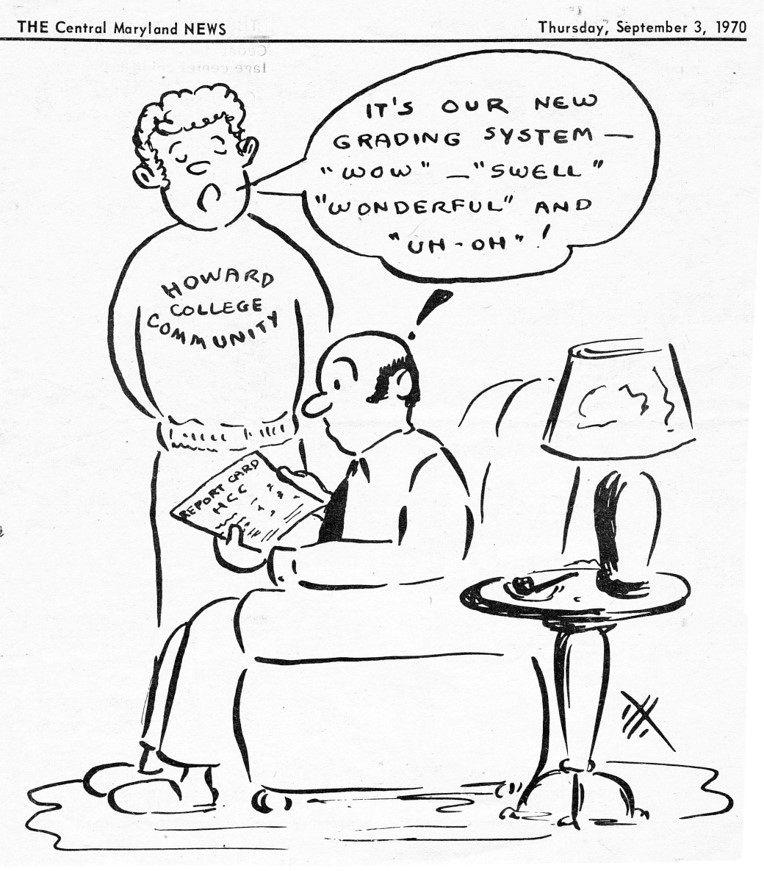
Applicants for the full-time faculty positions that would begin in the fall were interviewed early in 1970, and many of the hired candidates volunteered their time in the spring and summer to help with curriculum development, course descriptions, and helped the librarian to develop collections in their respective areas, and this was no mean feat since the development of courses, programs, and the library collection were all starting from scratch.
Fall 1970 saw the debut of the Mary Tyler Moore Show on TV and NFL Monday Night Football began. The Cleveland Browns beat the New York Jets 31 to 21. It was Richard Nixon’s second year as President, and the Orioles beat Cincinnati in the World Series, 4-1. Howard County’s County Executive was Omar Jones, who formerly had been Principal of Howard High School, and Howard Community College opened on Monday, October 12, 1970 in its just constructed one-building facility in Columbia, Maryland. HCC could claim “the distinction as the first Maryland community college to begin with its own, new campus and was the fourteenth community college in the statewide system.”19 But, the campus did not look like a college. Its massive concrete, two-storied, rectangular architecture looked more like an industrial facility than like a college. In addition, much of the land around the college had been cleared and so, the structure appeared to be in the middle of a field. Sometime during the first year Marinich recalls meeting someone who asked him where he worked. When Marinich explained the location of the college, the other party commented that he thought the building was a facility belonging to a utilities company.
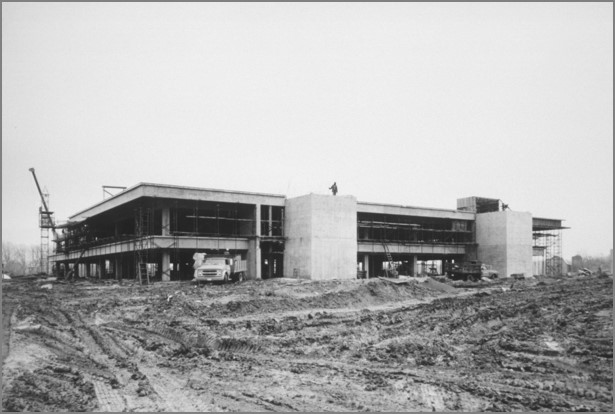
The October opening of the college was late, but the state approved the opening which was supposed to have happened in early September because of construction problems and delays; although, registration was still held in August at Slayton House in the Village of Wilde Lake, Columbia. A full-time student who registered for 12 to 17 credits paid $150 tuition. In-county tuition for part-time students was $13 per credit.
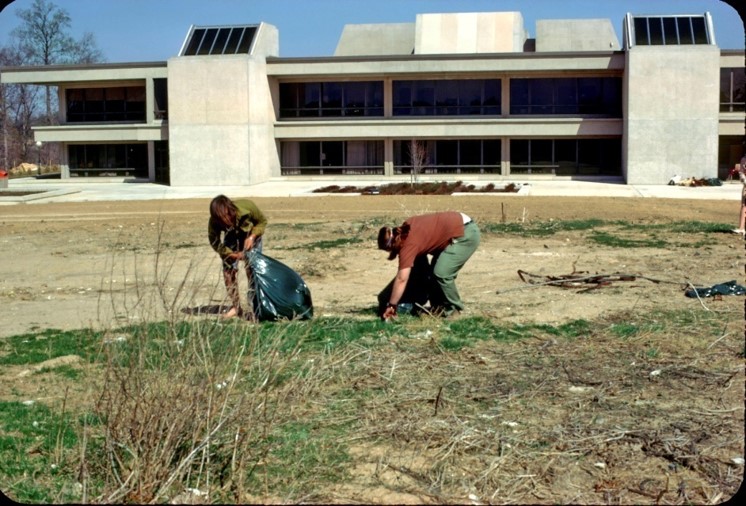
There was a total of 594 students who enrolled that fall; 240 of whom were full-time students and 354 part-time. This modest enrollment is understandable. The college, being brand new and, having no track record, was not yet well known in the county. Many of the full-time staff were new to the county. Several faculty had just recently moved into the county, and three senior administrators, the President, Dean of Faculty, and Dean of Community Service, had recently relocated from community college positions in New York State. The only native Howard Countian was the Director of Administration, Darrel Campbell. In addition, Catonsville Community College, which began in 1957, was a known quantity, and was established in the area, and had drawn many Howard County graduates for a number of years since it was virtually just across the border in Baltimore County. And further, there were the other established community colleges in adjacent counties that had drawn Howard’s citizens. Frederick Community College to the west also began operations in 1957. There was Prince Georges Community College south of Howard County that started in 1958 and Anne Arundel Community College to the east that opened its doors in 1961.
The first year of operation was one of getting, and becoming, organized. Policies and procedures were not yet fully developed, and those that existed may in some cases have been copied from the by-laws and policies of other existing community colleges. If this was the case, it certainly made sense since it avoided re-inventing the wheel; however, there was some initial confusion since this first set of Board of Trustees By-Laws had entries about faculty tenure and division chairs neither of which the college had when it opened; indeed, there would never be tenure, and division chair positions would not exist until the late “70’s.
In the first set of by-laws faculty were defined as “all full-time members of the professional staff including the President, Deans, Directors, Librarians, Counselors, teaching faculty and other such persons designated by the President due to their educational duties and responsibilities.”
The 1970-1971 academic year began with 10 full-time teaching faculty, one librarian, and about 14 part-time faculty. The first full-time faculty members were:
Daniel Friedman, Chemistry and Physics
Janet Holter, Secretarial Sciences
Donna Kirkley, English and Speech
Lawrence Madaras, History and Political Science
Vladimir Marinich, Data Processing and Sociology
Robert Newkirk, Physical Education
Alan Pipkin, Biology
Bruce Reid, Electronics
Elizabeth (Betsy) Siggins, Librarian
Shirley Symonds, English
Harold Sylvester, Mathematics
Seven of the ten first full-time faculty were in their late twenties and early thirties. We know some of the backgrounds of these early faculty; Friedman had taught for four years at the Community College of Baltimore as assistant professor of chemistry, Kirkley had taught at UMBC and Prince George’s Community College, Madaras had several years teaching experience at Springhill College in Alabama and then at Coppin State, Marinich came out of the computer industry but had done part-time teaching at American University, Newkirk had been Head Lacrosse Coach at Cornell University, Pipkin came from several years at the University of Arkansas, Reid came out of the electronics and engineering industry, Sylvester had taught at Harford Community College, and Symonds was “a relative neophyte to teaching.20
An orientation program was organized by the administration in August 1970 and, because construction of the college was not yet completed, the orientation program was held in the American Cities Building. The new faculty heard presentations by the County Executive, Mr. Omar Jones, James Rouse, and other county leaders. There were also workshops on teaching techniques, Human Potential sessions, and discussions on student motivation and student characteristics. Each faculty member was given, and asked to read, the then popular book by Jerry Farber entitled, The Student As Nigger: Essays and Stories. The language of the book was often crude and vulgar, but its point was that students had been treated as second-class citizens in the past, and how that had to change. The orientation program established a positive atmosphere to the start of the year, and to the college’s beginning, and Smith’s presentation during this session was of particular importance. He presented his vision that set the tone for the future. Smith began with a history of the community college movement in the U.S., its current state at the time, Maryland’s place, and his vision for the college. Smith described the college as being a vital part of the community; one that provided academic programs and also “short courses, lectures, concerts, foreign films, performing arts groups, refresher courses, seminars, clinics, panel presentations¼”21 He continued by focusing on the student. In Smith’s words, “the college will be learner-centered and not teacher – or discipline-centered. Concern for the learner should be foremost. As a matter of fact, I think we should abandon the term “teacher,” because I believe that it has no longer any relevance to education. Instead, I believe that we should be known as ‘directors’ or ‘managers’ of learners. This puts the learner at the center of the institution.”22
Smith summarized his vision by questioning “some long-standing practices in education and some of the sacred cows.” 23 He questioned the lecture method as the primary mode of instruction, suggested that the textbook should not be the sole medium for learning, criticized the normal grading curve, and the “punitive grading practices, such as ‘D’ and ‘F’,” and emphasized the need for behavioral objectives.24
The backgrounds, experiences, and capabilities of the faculty came in handy in the first year. Several of the full-time faculty taught across disciplines; Marinich taught Data Processing and Sociology, Madaras taught American History and European History, and Kirkley taught Speech and English. And when the mathematics professor became ill and hospitalized, Friedman and Reid took over the math courses.
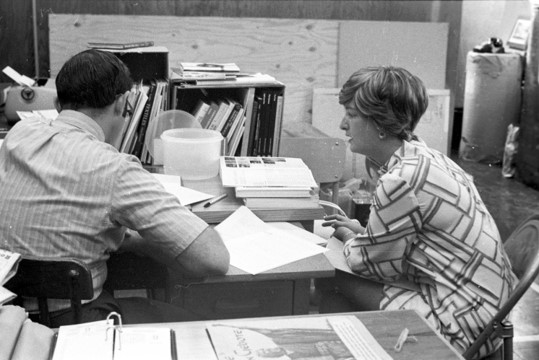
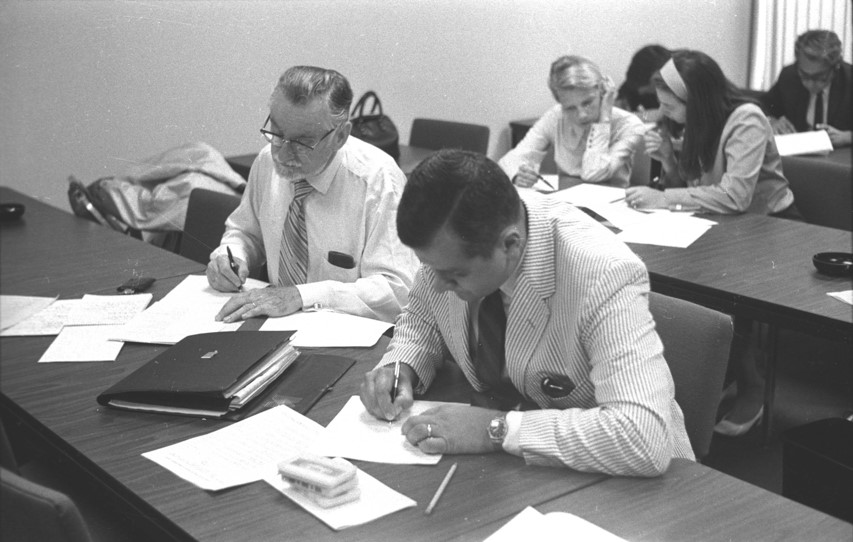
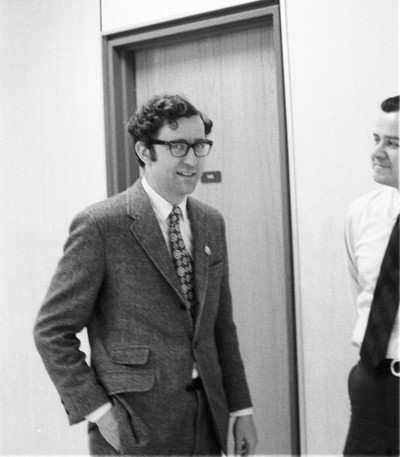
There were no departments or divisions. All faculty reported directly to the Dean of Faculty; not surprising since there was a total of twenty-four faculty, and just about each one was a department unto themselves and, in several cases, as already mentioned, some faculty taught across disciplines. There were no student evaluations of faculty, nor was there a formal planning and evaluation system for faculty or for administration. And everything was in one building: the classrooms, science labs, faculty offices, administrative offices, the library, bookstore, mailroom, necessary facilities, other management areas, and a cafeteria. The cafeteria was located in the southwest corner of the building. Chairs and tables were plastic, and sometimes, if someone leaned too far or rocked, the chair legs snapped off. Food and drink were out of vending machines in an adjoining room. The design of the building included a computer room with a raised floor for the many needed cables; but the college did not have a computer, so the room was used as an art studio for several years. (The reader is invited to study Appendix I for a three-dimensional rendering of the first building).
The college embarked on the systematic approach to learning in this first year. This became known as the Systems Approach. The particular approach that was taken was to have faculty develop clearly stated objectives by which student learning could be measured. The college demonstrated the commitment to this approach by employing Dr. Al P. Mizell as the instructional developer. It was his job to educate the faculty in educational theory, and to train the faculty in the development and use of behavioral objectives. Mizell worked with instructors as they developed their course and unit objectives, and he assisted the instructors to make sure that objectives were clearly, sequentially, and accurately stated, and that tests correctly matched objectives. During the year Mizell offered workshops and everyone who was responsible for developing objectives was given copies of Benjamin Bloom’s and David Krathwohl’s Taxonomy of Educational Objectives. Each faculty member was given both volumes, Handbook I on the cognitive domain, and Handbook II on the affective domain. The development of courses using behavioral objectives was seen as being of such importance and effort that in the first two years of the college’s operation faculty carried a teaching load of 12 credits rather than the standard of 15. In addition, a number of faculty visited Brookdale Community College in New Jersey to learn of their programs that incorporated individualized instruction and self-paced learning.
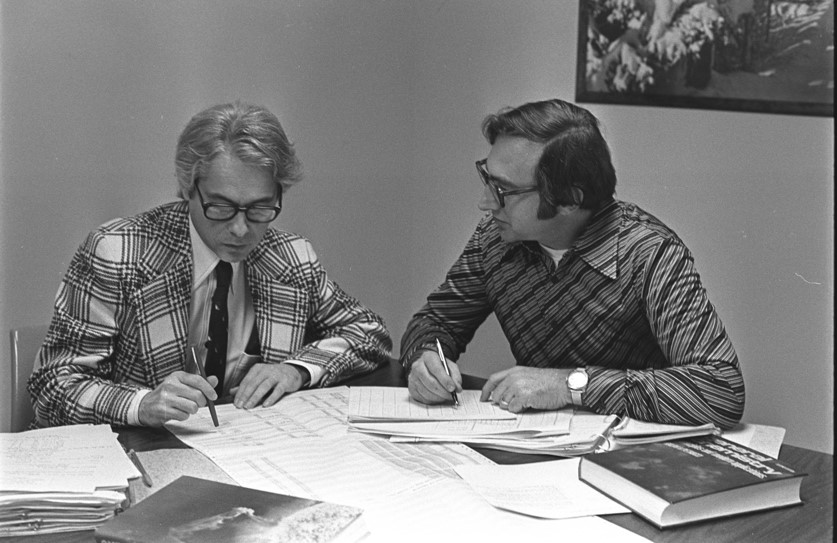
GETTING INTO THE SYSTEMS APPROACH
HCC’s pedagogical approach of using behavioral objectives and non-punitive grading drew some questions and criticism. There was no “F” grade; rather there was an “X” grade to signify student non-performance, but this grade did not calculate into a student’s GPA. There were some high schools in the county that had begun to use behavioral objectives and learning activity packages and, because the college employed similar techniques this led to some perception that HCC was “a high school with ash trays.” The non-punitive grading became the subject of a cartoon in one of the local newspapers.
There were a few individuals who had reservations about the “systems approach.” Dr. James Bell, who was employed in 1971 as the full time psychology professor, thought that while the concept of behavioral objectives was pretty clear, the administration did not have a unified sense or direction about what systematic instruction meant and this, he felt, created confusion.25 Dr. Jerrold Casway, hired in 1971 as the second full-time historian, thought that the school’s focus on the development of systematic instruction was damaging in that it made educational technicians out of faculty rather than enhancing their teaching skills. Virginia Kirk, hired to teach English the same year as Bell and Casway, concluded that focusing on what students had to learn and organizing courses and units within courses in an orderly, detailed manner, and in having learning organized in terms of end results (objectives) improved both teaching and learning. The instructor became more organized and the student understood what had to be learned.26 Peggy Armitage, who joined HCC as a Counselor in 1976 had pretty much the same thoughts on the matter, as did Bruce Reid who was one of the “originals,” and so did Andrew Bulleri, who joined the college in 1971 to teach mathematics and electronics.
Bela Banathy, author of Instructional Systems, conducted a seminar at HCC that basically dealt with the second phase of the college’s systems approach. The faculty had all gone through the initial program of learning to write behavioral objectives according to the Bloom/Krathwohl model and they were using those objectives in their classes. Now it was time for the next step. Banathy saw learning within the framework of systems; and in this he was influenced by the works of Robert M. Gagne and Robert F. Mager. Banathy’s design of instructional systems consisted of a six-step process:
Formulate Objectives
Develop Criterion Tests
Analyze Learning Tasks (ALT)
Design the System
Implement and Test Output
Change to Improve
Banathy’s entire approach and philosophy focused on learning, not on instruction. The student was the center and, if learning was the true focus of an educational institution, the way in which a student learns and the pace at which a student learns becomes critical. The consequences of such an approach were far reaching since it meant that in the ideal standard classrooms, traditional lecture courses, schedules, and even semesters became either obsolete or irrelevant.
Banathy’s model became the HCC model. The steps listed above became part of faculty responsibilities in ensuring that course materials, which would be in behavioral terms, would be validated by having faculty go through a rigorous, thoughtful process. Course and unit objectives had to be developed; that was fundamental. Quizzes, tests, and examinations had to be tied directly to objectives. The next part of the process was the Analysis of Learning Tasks (this quickly became known as the ALT). Faculty had to figure out what it was that a student had to learn in order to achieve an objective. This led to the next step that Banathy called Design the System. At HCC it became known as the development of alternative learning strategies (the ALS). This was the kicker! Since this entire intellectual process revolved around the student as learner, it became clear, as many already knew, that not all students learn at the same rate or in the same way. So, faculty had to develop alternatives within their own classes, and put them into practice. This became a major chore and simply did not work in many cases due to resource availability, the amount of time that a faculty member had to develop alternative learning modes, and finally the inflexibility of the semester system that required students to begin and end on fairly precise dates. The final stage of the system was to keep track of how things worked and to make changes, as appropriate, to improve the learning process.
In addition to this system being a requirement put on faculty as part of their professional obligation, it became a major part of the promotion criteria if faculty wished to move up through the academic ranks. Thus, a key element of a faculty member’s upward mobility in rank required pedagogical knowledge leading to better and more comprehensive instructional materials and approaches. To achieve the rank of professor a faculty member had to take at least one course through the entire process which, of course, would take a number of years. Marinich recalls that on a number of occasions over the years faculty observed that the level of systems knowledge and performance that they were expected to master were equivalent to going for a Ph.D.
There was more to HCC’s commitment to students than the “systems approach,” and this had to do with what was called “humanistic” education. The faculty were introduced to this philosophy right from the start when they were encouraged to read Jerry Farber’s outrageously-titled book. More than that, Smith supported faculty to participate in Achievement Motivation seminars and even to co-lead them once they acquired the skill. Terry O’Banion who is now best known for his book A Learning College for the 21st Century and as Executive Director for the League for Innovation in the Community College was invited to come to HCC in January 1972. He conducted a seminar/workshop that was attended by faculty, counselors, and some administrative staff. It dealt with the human side of education, and a number of ideas that O’Banion shared with the staff back then, in the early 1970’s, could still be found in his more recent works. The college also developed and conducted workshops on communication, listening skills, and what became known as Level II Advising that became part of the faculty/professional development repertoire. This was in addition to those professional development activities that were about developing behavioral objectives, ALT’s and ALS’s, criterion testing, etc.
WE WERE SMALL, BUT BURGEONING
During the college’s planning and development in 1969, and during HCC’s first year of operation, Student Services was under a Director, who also handled admissions. This was Dr. Dean DesRoches. There was a Registrar with an assistant, and one counselor. The Director reported to the Dean of Faculty, and the Registrar, who at that time had the title of Recorder, while officially under the Director of Student Services, really reported to the Dean of Faculty. A Student Government Association (SGA) was formed and a faculty member, Marinich, served as advisor. One of the first student activities was a dance held in the college’s cafeteria on Friday, November 20. A local group, “Liquid Fire,” provided the music. A student newspaper, The Tabloid, also began in 1970, and it, too, had a faculty advisor. The newspaper was, indeed, in tabloid format. It was four pages long with the first page devoted to college news and the last to sports; the inside (second) page was letters to the editor and op/ed articles that often spilled over to the third page; and often enough students were critical of some college process, schedule, actions of some college official, general suspicion and occasional rejection of authority, etc. Not surprising, since the early to mid-1970’s were part of the 60’s. Or, as stated by the historian, Paul Boyer, “the sixties cast a long shadow, and the decade’s political and cultural trends did not vanish as the new decade began.”27
Community Services (later to be changed to Continuing Education) was a dean’s level position, and it was administered by Joseph DeSantis who had been hired in 1969, as had the other senior administrators. In addition to offering courses DeSantis also established an aggressive program of getting the college involved in community activities. He encouraged faculty to be involved in the community by developing a speaker’s bureau and by encouraging faculty to teach a credit-free course in whatever area was appropriate. At the very beginning Community Services, under DeSantis, scheduled credit-free courses and also scheduled evening credit courses. In fall 1970 DeSantis’ area scheduled 28 credit-free classes and 33 evening credit classes. The evening credit classes were all scheduled on campus, and all but one was two evenings a week. All the credit-free classes were scheduled at Howard High School, Mt. Hebron, the Howard Vocational Technical School, Faulkner Ridge Elementary, and Wilde Lake Middle School (Wilde Lake High School, the first high school in Columbia and the fifth in the county, did not exist yet; not until 1971). We do not know how many of any of these courses had sufficient enrollments to run. Daytime credit classes were under the Dean of Faculty. The fall 1970 schedule listed 73 day classes. The schedule was all of four typed pages, single-sided, on 8½ by 11 paper; five pages, if the cover title page was included. We also do not have data on the number of day credit courses that had sufficient enrollments to run.
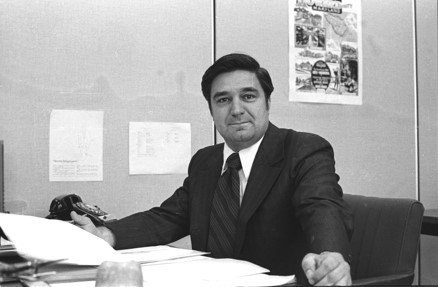
The following year, 1971, was, as are all years really, eventful for the nation, for the county, and for HCC. The Pentagon Papers were published, thereby heightening the controversies over Viet Nam even more; the 26th amendment to the Constitution was passed, lowering the voting age from 21 to 18, Starbuck’s began in Seattle as a single coffee shop, and the Columbia Mall opened with two anchor stores; Woodward & Lothrop and Hochschild Kohn.
In March of 1971 the first faculty organization was established. It was named the Faculty Association and its membership was perhaps a little over thirty members. This membership included teaching faculty, both full-time and part-time, and administrators, that included the deans and the president. The first officers of the Association were Madaras as Chair, Marinich as Vice Chair, Kirkley as Secretary, and Friedman as Treasurer.28
Toward the end of the spring semester Symonds, the full-time English faculty member tendered her resignation. Marinich recalls that she was not in agreement with the innovative philosophy and practices at HCC and, therefore, felt that she should leave. Kirkley, on the other hand fully expected to continue; however, her contract was not renewed due to her “personal physical condition.” She was pregnant. On March 24, 1971, Kirkley received a letter from the Dean of Faculty in which he praised her for her contributions to the college, but said she would “not be offered a full-time professional contract for the 1971-72 school year.” His letter further stated,
I know that you will thoroughly enjoy your soon-to-be motherhood status, and most wholeheartedly encourage you to reapply at HCC when you are ready to return to teaching.
Smith concurred.29 It should be noted that this was 1971, and the Pregnancy Discrimination Act was not legislated until 1978. Several years later Kirkley returned to the college. In 2004 she retired with the rank of Professor Emeritus.
May 23, 1971 was a sunny spring day in Howard County, and ideal for the dedication ceremony that was held outside of the main entrance by the flagpoles. There probably were not many more than about 100 people in attendance, including college staff, the platform party, students, and members of the community. The major address was given by the Lieutenant Governor of Maryland, Blair Lee III. There was also the presentation of the keys. The Howard County Executive, Omar Jones, presented the keys to the campus, and Fred Carey of the Perkins & Will architectural firm presented the keys to the buildings. The keys were accepted by Frederick K. Schoenbrodt, who was the Chairman of the first Board of Trustees of the college.
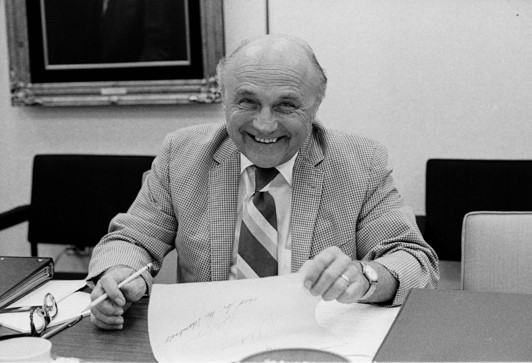
That summer the college introduced the Summer Grant Program that allowed faculty to receive stipends to work on program development, course improvement, and some professional development activities, while they were off contract. Faculty had to propose a project that was clearly seen to be of value to the institution. In that first year the Dean of Faculty and the Instructional Developer reviewed the proposals and chose those that would best serve the institution. The Summer Grant Program has continued every year since then, thereby becoming institutionalized.
The second year – the 1971-1972 academic year, was probably as exciting and dramatic as was the first. In his talk with the faculty at the beginning of the first year, Smith had understood that the initial phase of the college would be an interim period during which time “the best practices will be used temporarily as guided progress is made toward the post-interim period when effective innovative practices will be a reality.”30 While his focus was on educational processes, it was clear that such practices would require an organization that could get this done and that more staff were needed as the college grew. And the college had grown; full time enrollments were 337 (up from the prior year’s 248), and part time enrollment was up from 363 in 1970 to 390.
There was a major reorganization in the student services area. The director, counselor, and registrar had left in the summer of ’71. The new organization of this area would have a Dean of Students. Dr. John Fiedler, who had gotten his Ph.D. from the University of California, was hired for this position and, given the position as dean’s level, he reported directly to Smith. Five counselors were hired, and all had administrative responsibilities in addition to their counseling duties. These were the individuals and their administrative duties:
Charles Dassance, Financial Aid
Diane Downey, Career Counseling
Frank Gornick, Admissions
Katherine Kelleher, Student Activities
Robert Levene, Veterans Affairs31
Of the people named, almost all left within a few years primarily “because the rapid growth of community colleges created enormous opportunities for experienced community college administrators.”32 Dassance and Gornick left to move on with their careers, and eventually became community college presidents and, as a matter of fact, over the years HCC produced a number of presidents. (See Appendix II). Downey left to go into the banking field as a trainer, and Kelleher subsequently married and moved away with her husband. Levene remained, became head of counseling, and then moved to faculty status. He retired in 2005 as Professor Emeritus of History at HCC.
That same year faculty ranks increased with the hiring of the following:
Martha Aldrich, Nursing
Faye Armstrong, Secretarial Science
Claire Benjamin, English
James Bell, Psychology
Andrew Bulleri, Electronics and Mathematics
Ronald Carter, English
Jerrold Casway, History
Bernadene Hallinan, Director of Nursing Education
Roslyn Judy, Art
Virginia Kirk, English
Vincent Koehler, Mathematics
James MacGregor, English
Richard Matlick, English
Ann Marie Zalewski, English
Again, there was a mix of backgrounds and experiences. Bell had previously taught at Elmira College in New York, Bulleri came from Western Illinois University with six years teaching experience, Casway had just earned his Ph.D. in History from the University of Maryland and had been a graduate teaching assistant and had taught as an adjunct faculty member. Kirk was a recent recipient of her M.A. from Michigan State University, and Matlick had a number of years experience at several community colleges.
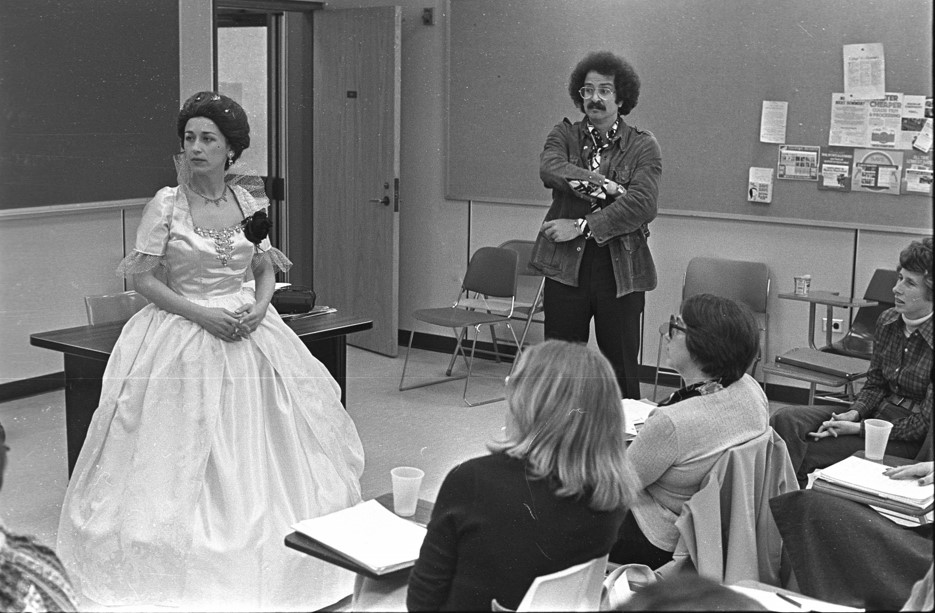
In addition to all these faculty and counseling positions two administrative positions were created; one was Director of Funding and Development, David Tucker and the other was Assistant to the President for Public Relations, Dagmar Grimm.
Smith was also concerned about the relationships between major units of the college, constituent groups, and how policies and procedures would be integral to all of these. In July 1971 he established a task force on Internal Governance to develop a set of recommendations on the structure and governance within the college that he could review and recommend to the Board of Trustees for approval. The result was the creation of a College Council and three committees; Curriculum and Instruction, Community Services, and Administrative Services. All these bodies would have representatives of HCC’s constituent groups; administrators, faculty, staff, and students.
As in the first year the college had four transfer A. A. degrees, four career degrees, and one certificate. The transfer A.A.’s were Arts and Sciences, Business Administration, General Studies, and Teacher Education. The career A.A.’s were Accounting, Business Data Processing, Electronics, and Executive Secretarial Science. The one certificate program was Stenographic-Clerical, and this was a one-year Certificate of Proficiency.
A Nursing Program was in the planning stages, but was not yet established. To get the program under way for the following fiscal year a Director, Bernadene Hallinan, and a faculty member, Martha Aldrich were hired. Both had been at Corning Community College and had worked under Smith.
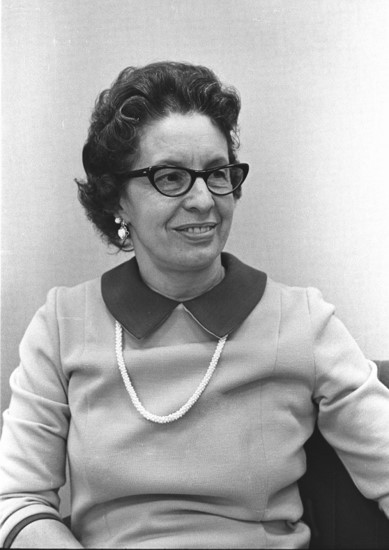
1971 was the year that the school’s official colors were established. In the few months prior to December of that year, the SGA and its faculty advisor reviewed the symbolic meanings of various colors by looking through historical and heraldic sources. Finally, a poll of 180 students was conducted via a questionnaire to determine the school colors. The selection was maroon and ivory.33 That month’s HCC newspaper, The Tabloid, was printed in red on off-white paper. This may have been in recognition of the school’s new colors, since the newspaper was generally printed using black ink.
In January 1972 the college ran its first “minimester.” This was the term used for the winter intersession period. Three classes were offered with an enrollment of 36 students.
In the early spring of 1972 a short-lived faculty evaluation process was established. It consisted of a self-evaluation by the faculty member, peer evaluations by three of four peers that the faculty member felt were “qualified to accurately evaluate his performance,” and an evaluation by the Dean of Faculty.34
THE CHANGE AGENT
The summer prior to the start of the 1972-73 academic year was a particularly active season for the administration. Of the four senior administrators who reported to the president, three left the college; the only one remaining was Joseph DeSantis. The president upgraded the Administration Director’s position to dean’s level and he hired Richard Pettingill to be the Dean of Administration. Pettingill had been Smith’s colleague at Corning Community College. Search committees were formed to review applications, interview candidates and make recommendations to the president for the other two positions. A Dean of Instruction (this was the new title) and a Dean of Student Services were hired during the summer. The new Dean of Student Services was Dr. Robert Anderson, and the new Dean of Instruction was Dr. Donald J. Donato. The latter was a very forceful presence, and his tenure at HCC set a direction that would last for many years. Donato had earned his B.S. and M.S. from the State University of New York, and his Ph.D. in Counseling from the University of Missouri, and had most recently been employed at a Pennsylvania community college as Dean of Students and Director of Research. As the staff came to know him it became clear to many that he was on a career path to a presidency.
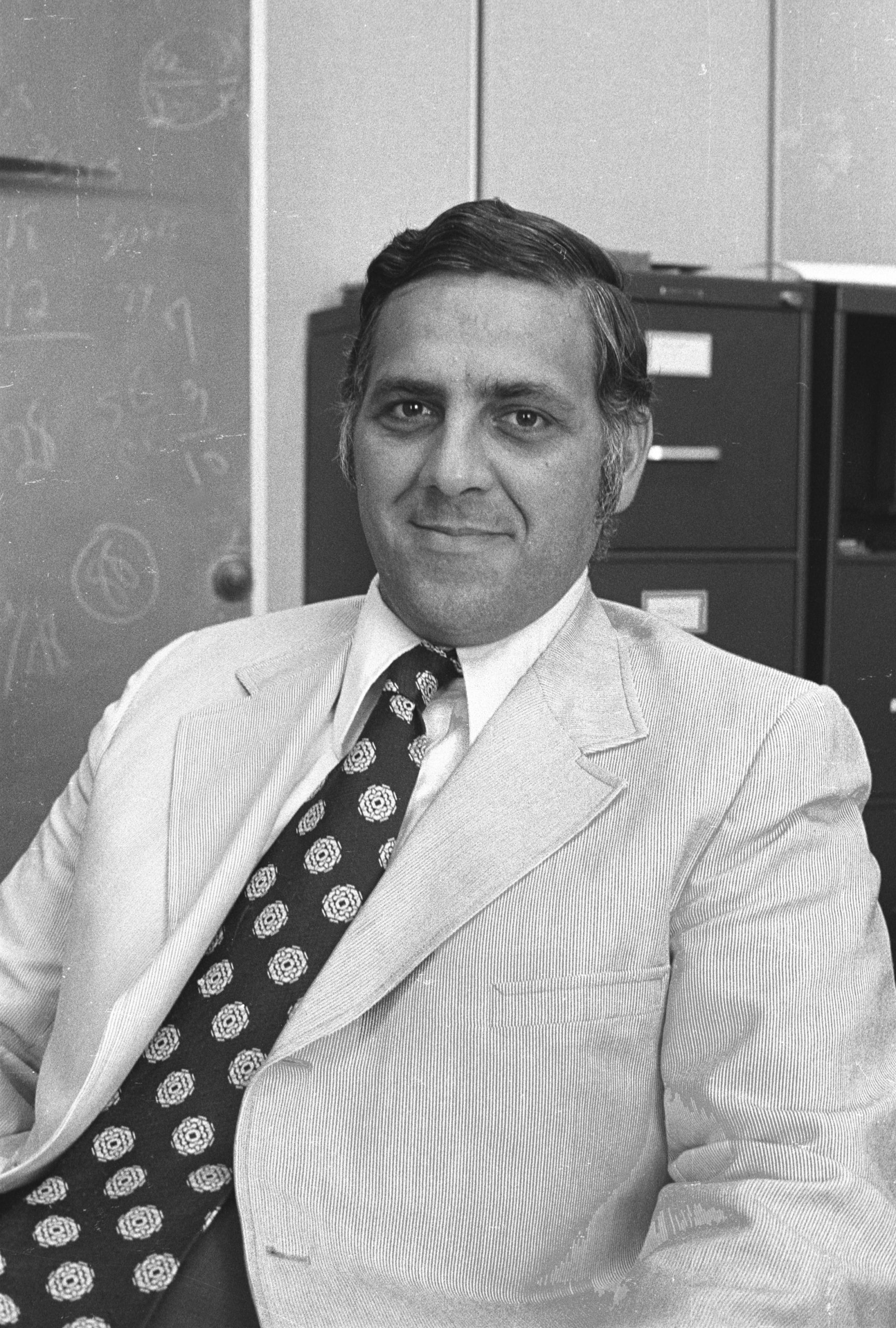
Donato saw himself as a change agent and, with the president’s concurrence, he began to develop a quantitative faculty evaluation system as one of his first major responsibilities. One or two faculty committees were established to come up with the foundation for a more objective faculty evaluation system. The background to this is founded in the prior year’s faculty evaluations that proved disappointing to some individual faculty members. Communication had not been clear on the nature and consequences of faculty evaluations, and the entire process, at least in the eyes of some faculty, was not organized or executed consistently and apparently with little or no faculty input in its development. The evaluations were based on a combination of self-evaluation, peer evaluation, and evaluation by the Dean of Faculty. All these elements were subjective in that only the most general guidelines were given as to how the evaluations should be conducted.
Donato was influenced by the work of Wilbert McKeachie of the University of Michigan, who is an authority in the areas of psychology, teaching at the college level, and active learning. Donato visited McKeachie to show the latter a draft of Donato’s evaluation system, and returned encouraged that McKeachie thought it had some positive attributes. Donato verbalized this to Marinich at the time.
The Faculty Evaluation System quickly became known as the FES. The first draft was developed in October 1972, and was 17 pages long. The content of these pages was a highly detailed description of faculty responsibilities in the following categories: teaching load, student advising, administrative responsibility, program/instructional development, college/community service, and personal/professional development. Each of these areas was assigned a point value and the estimated time requirement, in hours, for their accomplishment. In addition, each one of these areas was further broken down into more detail. Teaching was broken down into point values awarded for the number of preparations, student credit hours generated, and contact hours. In college service, as an example, a faculty member accrued ¼ of a point for attending “a student activity such as a dance, concert, etc.”35 A faculty member was generally supposed to accrue 71 points in a year as an average, and was to put in an estimated 1,405 hours of effort. Salary increases were based on total points accrued.
While there were areas of the system that required faculty to plan an activity, such as a pedagogical project, most of the system contained prescribed activities with little planning, in the way of forward thinking, on the part of the faculty. It may be interesting to note that the FES was reminiscent of early twentieth century industrial management, which was the era of such researchers as Frederick Taylor and the Gilbreths, and of time/motion studies that attempted to improve worker efficiency. The flaw in those systems was demonstrated in the famous Hawthorne studies of the late 1920’s and early 1930’s conducted at the Chicago GE plant where motivation was seen as a major component of worker satisfaction, rather than just remuneration for more efficient work; thus, the FES was flawed in that it was almost entirely the accumulation of points. One of the few areas where the quality of performance was assessed was in the area of the faculty member’s development of “systematic learning.” The instructional developer could evaluate a faculty member’s thoroughness in developing behavioral objectives that were in keeping with the Bloom/Krathwohl model.
A surprising and curious entry, attributed to Donato, is found in the HCC Board of Trustees Minutes for October 19, 1972.
Dr. Donato pointed out that the system involves an aggregate of points which may tend to dehumanize. However, if a professional posture is maintained by faculty, this may not be a problem.
If this entry is an accurate reflection of what was said, it is surprising that the Dean of Instruction would admit to establishing a system that “may tend to dehumanize,” and it is curious that faculty would be expected to act professionally under such a system.
In addition to developing the FES, another of Donato’s very early efforts was to develop an organizational structure within his area. In August 1972 he convened a College Workshop to discuss various issues; among them was how to organize “the Instructional Program. His words:
How should the instructional program be organized?
Should there be the conventional department or divisional configuration?
What about the House or Cluster concept?
What about an interdisciplinary or career family configuration?36
Donato also wanted to discuss how the Learning Lab (somewhat like HCC’s later Learning Center) would fit into the organizational structure that would be developed. We do not have specific information on what conclusions were reached at the end of the workshop; however, Donato developed a Cluster organizational structure. This approach was based on the work of John Holland, a professor at the Johns Hopkins University. Holland’s research into personality types and career choices was developed into his Self-Directed Search (SDS), an instrument that tested a person’s abilities and interests and, on the basis of the results of this questionnaire-type test, suggested various career and employment choices that would be in keeping with the person’s background. The SDS categorized people within a six-fold typology. There were individuals who tended to be Realistic, Investigative, Social, Conventional, Enterprising, or Artistic. Individuals could also have several of these characteristics, with two or three tending to be more dominant. This became the basis for the Cluster concept of organization of the faculty. Two clusters were created; one was the Applied Human Services/Artistic, and the other was Applied Management/Social Science. Based on Holland’s work, the various disciplines were matched to his typology. Thus, Nursing, other allied health programs, English, Art, Music, and Science all tended to be associated with Artistic, Investigative, and Enterprising characteristics. Accounting, Business, Data Processing, Secretarial Science, and Social Science were identified with Social, Realistic, and Conventional characteristics. But, there were a few areas that did not fit neatly into these two categories; at least, not organizationally. Developmental courses were put under the Coordinator of the Learning Lab, and the two fulltime math faculty were divided; one was assigned to “Cluster 1,” and the other to “Cluster 2.”
While much of this was going on, the college’s life continued to be vital and exciting. Work on preparing for accreditation began in 1972 with the development and collection of general information about the college, listing and describing programs, student demographics, college bylaws and policies, procedures, long-term goals, and any other data that would be needed for accreditation. In addition, other colleges were contacted to see how they handled their accreditations, and the Middle States Association was contacted to send the college all necessary information on their accrediting policies and procedures.
HCC’s first commencement was held on Sunday, June 4, 1972 at 2:30 P.M. at the Wilde Lake Interfaith Center. The week prior to the commencement the entire faculty met to approve the list of candidates for graduation. This was more than a formality, since the Registrar had to inform the faculty of any potential problems that a student might have in graduating, or a request that a student be allowed to walk across the stage in anticipation of completing his/her credits by summer. This practice continued for several years. Again, the college did not yet have a facility that was big enough to have a graduation ceremony, or any other large convocation for that matter. Indeed, the single largest room at the college was a tiered lecture room that could hold 72 students. There were 36 graduates at that first commencement; 35 received their Associate in Arts degrees and one received her Certificate in the Stenographic/Typing program. Terry Sanford, the President of Duke University, and former Governor of North Carolina, was the main speaker at the graduation. He was also a candidate for the 1972 Democratic nomination for President of the United States; however, Senator George McGovern of South Dakota got the nomination and in November lost the election to the incumbent, President Richard Nixon.
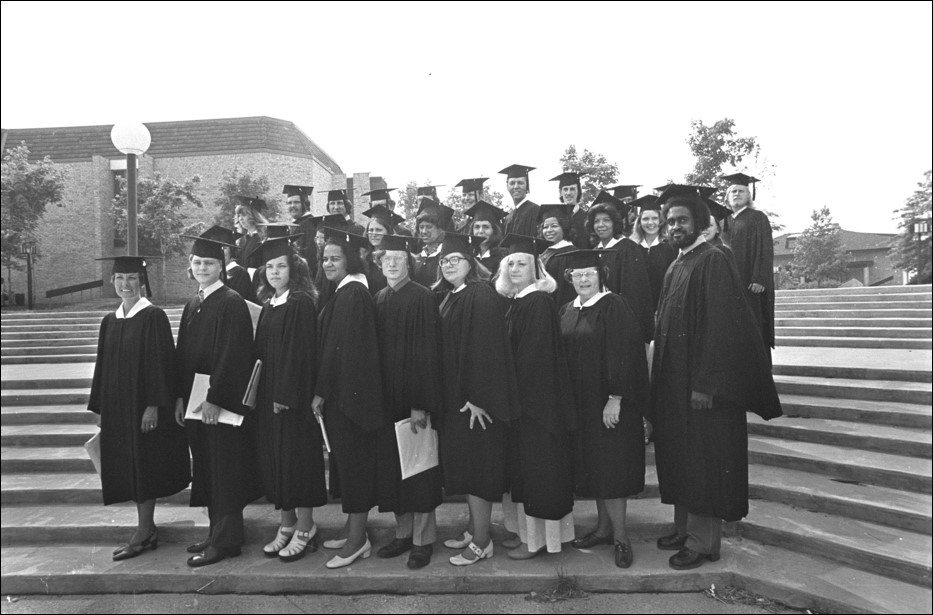
HCC’s sports program began in earnest in fall 1972 with the formation of a college basketball team. Its season was from December 1972 through February 1973. In its first home game HCC defeated Cecil Community College 115-60. The home games, by the way, were played at Wilde Lake High School, since the HCC gym did not exist yet.

HCC’s first international trip was planned during the Fall 1972 semester, and in January 1973 approximately 22 individuals went to the Soviet Union for two weeks. The group consisted mostly of community residents, but there were four HCC students and one math faculty member who were part of the group. The trip was led by an HCC faculty member, Marinich, and the group visited Moscow and Leningrad and, in addition to the historic sites in each of these cities, saw an opera at the Bolshoi Theatre in Moscow, attended a performance of the Kirov Ballet in Leningrad, and met with young Soviet students at a local school and at a youth center (known as the “Pioneer Palace”). The entire trip cost a participant $495.
The fall 1972 semester also saw its share of student involvement. The Student Government was particularly active in promoting various student social events, dances, occasional guest lectures, and also in being the voice for students in general. The student newspaper continued into its third year of operation and also acted as the voice of the students. Some of The Tabloid staff saw themselves in a new light. In a short informal conversation that Smith had with Marinich at the time, Smith mentioned that a student had contacted Smith’s office to set up an interview with him. When asked what the purpose of the requested meeting was, the student answered that she was an investigative reporter for The Tabloid and told the president’s secretary that investigative reporters should have free access to the president. Marinich recalls that Smith was amused.
Around November 1972 there was quite a bit of student discontent that surfaced. The issue was the class schedule for the spring 1973 semester. Students complained and got a meeting with the Dean of Student Services, Dr. Robert Anderson. The meeting was held in the cafeteria and about 100 students attended. Several faculty members were there, as well as a representative of the local newspaper, the Columbia Flier (which at that time was printed on 8 x 11 paper). The major complaint was that the number of courses and sections scheduled for the spring was very limited; some courses had only one section. One student noted “that many of the second year level courses had only one section making it difficult for working students, housewives and returning veterans to make out their programs without a time conflict.”37 From the college’s perspective, the issue was one of cost effectiveness; it was better to have fewer courses with larger enrollments than more courses with smaller enrollments and the possibility of having to cancel low enrolled classes. The students at the meeting preferred the second alternative. The following week the college added three courses and an additional section of another course in an attempt at compromise. Students were generally still not satisfied and there was an attempted boycott of spring registration. There was a low student turnout for the boycott and the matter “fizzled.”38
PROGRAMS, NATURE WALKS, AND GROWTH
1973 was dramatic in many ways throughout the world. It was the year of the signing of the peace treaty between the U. S. and North Viet Nam in Paris. We also saw petroleum prices double; Spiro Agnew, the Vice President, resigned, the trial of the Watergate burglars began, and the Supreme Court decided Roe v. Wade.
At HCC there were a number of continuing major activities. Beginning in January 1973, “more than 250 military veterans (had) been discharged from active duty and (had) returned to the Howard County metropolitan area.” 39 The college introduced “Project Outreach” which promoted educational benefits to the veterans. The college hired Stephen Turner, himself a vet and HCC graduate to coordinate the program. By spring of that year there was also a major reorganization planned for the following academic year. The Dean of Students had resigned and the Student Services area was put under the Dean of Instruction and a new position, Associate Dean for Student Services, was created; so, to a certain extent this structure was similar to the first year’s. This Associate Dean was responsible for Admissions, Records, Financial Aid, Athletics, and Institutional Activities/Evening coverage. Counselors, however, were now assigned to the Clusters and Learning Lab and, therefore, they reported to the heads of those areas. The individual hired for the Associate Dean’s position was William Snider. He came from the Pennsylvania community college system and had been acquainted with Donato.
Another Associate Dean’s position was created to be responsible for “career education.” This office was responsible for developing career programs; surveying employer needs, student interests, needed resources for the creation of new programs, and putting together the curricula with the help of appropriate faculty and cluster chairs. Dr. Arnold Maner was hired in this position. He had prior vocational education experience and had recently earned his Ph.D. from Texas A & M. Maner left after two years to write a proposal for a community college for the eastern shore, and subsequently became the first president of Wor-Wic Community College.
In the Administrative Services area, the Dean of Administrative Services centralized all word processing. This meant that all requests from faculty or administrative personnel were handled by a single centralized group of word processing employees. In 1973 there was a supervisor and three operators. To make operations more efficient a system was put in that allowed faculty and other staff to call the Word Processing Center via telephone and dictate letters, memos, or whatever, into dictating machines which would then be transcribed. It did not work well at all and was terminated within a few years.
New programs were added in 1973: Bio-Medical Engineering Technology (both A.A. and certificate), making HCC the first school in Maryland and one of the few on the East Coast to offer such a program; the other new program was a certificate program in Retailing. So, the college catalog that started with ten programs in 1970, and continued that way for the next two years, now had thirteen. Or, fourteen, if one counted two pages dedicated to the Arts and Sciences A.A.; there was now the Liberal Arts Emphasis, and the Science Emphasis.
HCC’s first literary journal, Sprouts, was published in spring 1973. It was 48 pages in length and had student poems and essays. This journal would continue over the years, but would change names several times; after Sprouts the names, in sequence, would be Echoes, Tomorrow’s Voices, Iron Horse Express, Ink on Paper, and now it is The Muse.
Sue Bard and Roland “Chip” Chapdelaine of the science faculty had worked on the creation of a Nature Trail on the grounds of the college, and in the late summer it became a reality. This “Woodland Walk” was created and designed to be available to the community as a natural plant and wildlife habitat. Bard and Chapdelaine produced a guide booklet and Bard produced an audio recording narrated by “Scampy the Squirrel.” Scampy became quite a draw for community residents and youngsters visiting the nature trail.
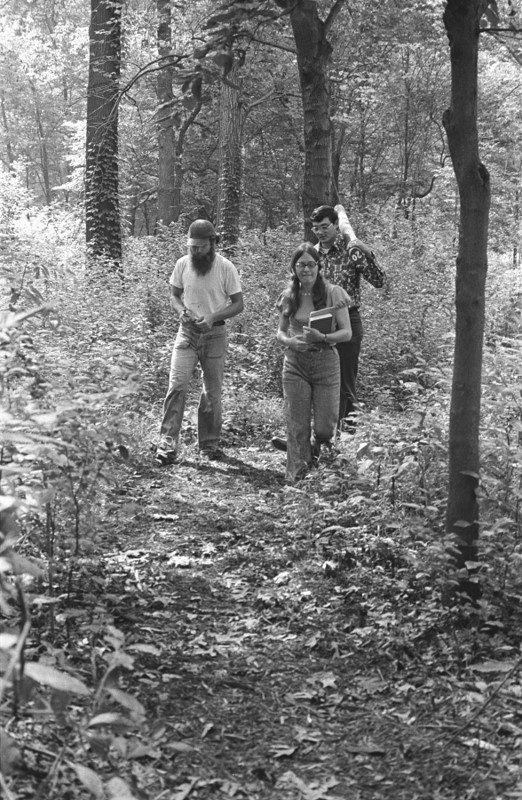
ACCREDITATION
While a lot of data gathering on how accreditation worked had been going on for quite a while, the process really went into full swing in October, 1973 with Donato’s call for a nominating committee to select an accreditation steering committee. This would be the group that would oversee the entire process. By January 1974 a steering committee was in operation and a thorough plan was formed for accomplishing the accreditation process. Functional committees were established to look at various elements of the college. The functional committees were:
Administrative Organization Committee 8 representatives
Academic Program Committee 10
Student Committee 10
Faculty Committee 7
Learning Committee 9
Instructional Resources Committee 7
Finance and Facilities Committee 8
Lay Advisory Committee 6
Each committee had student, faculty, and administrative representation, except for the Lay Advisory Committee whose role was different from that of the other committees. Depending on the particular committee the constituent representation would vary; so, the Student Committee had five students of the ten members on that committee; the Faculty Committee had five faculty of the seven members on that committee. A Board of Trustees member, Dr. Charles Leonard, was on the Administrative Committee.
The Steering Committee membership included
Donald J. Donato, Dean of Instruction, Chair
James E. Bell, Faculty, Vice-Chair
Andrew A. Bulleri, Faculty
Theron Jackson, Student
Susan Potts, Administrator
Ann Marie Zalewski, Faculty
Virginia Kirk, Faculty, Writer
Each member of the Steering Committee was also a liaison to one of the seven functional committees thereby ensuring the best communication between the committees. Not only did the liaison person report back to the Steering Committee, but chairs and representatives would also meet and report to the Steering Committee.
The Lay Advisory Committee’s role was described thus:
The following individuals were asked by the College to serve as a community advisory panel in conjunction with Howard Community College’s accreditation process. Their tasks were to react to the Self-Evaluation Document and to provide the College with some community perceptions of the College’s development.
Norman G. Bitterman, Awalt and Clark Realtors
Jean Carter, Columnist, Columbia-Howard County Times
Edward L, Cochran, Howard County Council
Howard G. Crist, Jr., President, Farm and Home Service, Inc.
Anita Iribe, Owner, Page 1 Book Shop
David Tucker, Director of Performing Arts, Columbia Association 40
The accreditation process was very time consuming and a major effort on everyone’s part, especially between January and July 1974. While there had been a problem back in October 1973, with some faculty concerns that the process might not be as open as was thought 41, the emerging process of committees and representations did allow for an open and transparent process that included students, faculty, administrators, a member of the Board of Trustees, and community persons. And, faculty chaired four of the seven functional committees and were represented by four of the seven members of the Steering Committee.
The result of all this work was the Self Evaluation Report for the Middle States Association of Colleges and Secondary Schools in July 1974. The report was 246 pages long, including introduction, a five-page table of contents, appendices, and 188 pages of narrative.
Professor Virginia Kirk, who was the official editor for the development of the Self-Study Report recently reflected back to that time and said that very few of the people involved in the process, as almost everyone was, had ever been involved in accreditation. She said that people were not quite sure what they were doing, but they certainly worked very hard. 42
The publication of the Self-Study Report was not the end of all this hard work. The college now had to get ready for the visit of the accreditation team, which was scheduled for late October. And, the Nursing Program was scheduled for its own visit from a nursing accreditation team at the same time.
By December the college was well on its way to receiving accreditation. The visits went well and the report of the Middle States Association was very positive; although a few points were made as recommendations. One comment was that the role of the counselors needed to be better defined. This was certainly understandable since in the prior four years counseling, and the entire student services area, had been reorganized in major ways four times. The visiting team also stated that among some problems “the most notable of these are the concerns over the evaluation system and the confusion about the true values and successes of systems learning.” 43 The Nursing Program had also gone through a self-study and was also accredited, and in January, 1975 President Smith received a letter from the National League for Nursing that the League had granted the HCC Nursing Program accreditation “with no progress reports requested by the League.” 44 This was high praise and virtually unconditional accreditation.
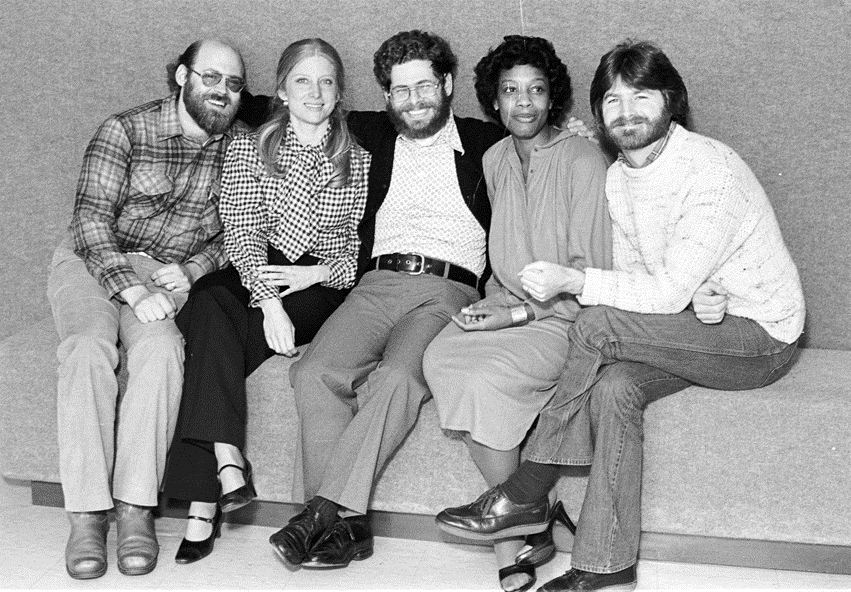
THE COLLEGE AND THE EVALUATION SYSTEM GROW
By 1974 there were 1,459 credit students; 429 full-time and 1,030 part-time. The enrollments had grown by almost 10% over the prior year. By November the Faculty Evaluation System (FES) was in its sixth revision and was 80 pages long, from an original 17 pages in 1972, as already mentioned. In that month there were 20 pages of corrections, modifications, and clarifications that were generated to the FES. The FES had become a major presence and an overwhelming preoccupation at the college. Not only were faculty, for the most part anywhere from concerned to unhappy with the system, but administrators of other functional areas had to provide information to the instructional area about their needs for faculty involvement, how many hours this involvement would require, and how many points would be awarded. Everyone involved had to focus on the most minute details, and details there were. There was concern over the number of things that people had to do and the amount of time to do them. Donato addressed one of these issues from a contractual perspective. He provided a lengthy analysis of faculty requirements. An example of the detail in his own words:
If we use a 43 week base from August 25 to June 25, subtract three weeks of vacation-like benefit (June 7 – 25) and 8 days of paid holidays, we arrive at a 38.5 week basis. Dividing the above time parameters by 38.5 results in a work week of 39/41 hours per week. Adding the 25 hours of personal time would result in a 41.5 to 43.5 hour week for Level 3 expectation.45
The concern and focus on hours and points became counterproductive simply because the system was based on time spent on activities with little thought being given to planning, quality of performance, or individual initiative. The FES was overdeveloped. Shortly things would change for the entire college.
1974 was the year that HCC’s physical appearance began to change. Construction began on the Nursing Building and HCC applied to the county’s Water Resource Administration to build a lake behind the Main Building which, at the time, was the only building. The cost to build this lake was estimated at $12,000.46
The Community Services area was establishing training programs with various businesses and industries throughout the county. The college received its first Comprehensive Education and Training Act (CETA) contract to train unemployed qualified applicants in office clerical skills that would make them employable, and Community Services offered over 100 credit-free courses throughout the county in the Winter 74/75 term. It can be argued that Community Services may have been a major factor in those early years in getting the good reputation of the college known to the community. But, as in all things, success and good will are not always without some criticism. In early 1975 a letter to the editor of the Howard County Times was published complaining that of 137 credit-free courses offered by HCC, 115 were in Columbia and 18 were scheduled throughout the rest of the county. If this was a problem it must be remembered that Columbia was growing rapidly and the county’s Department of Education was building schools where the population was, and HCC’s credit-free courses were scheduled in county schools for the most part.
Elsewhere, Route 40 sprawl was beginning to show itself; more gas stations, fast food places, little strip shopping centers. Closer to HCC, some of the functions of the Columbia Medical Plan, which had been housed in the office complex across from the college on Little Patuxent Parkway temporarily relocated to the recently constructed Howard County General Hospital.
On the national scene people were reading Marabel Morgan’s The Total Woman and Woodward and Bernstein’s All the President’s Men. Two popular films of the year were “Blazing Saddles” and “Alice Doesn’t Live Here Anymore.” Alexander Solzhenitsyn, the dissident Russian author, was expelled from the Soviet Union and, back here in the States, Richard Nixon resigned the presidency in August.
MBO’S AND ALL THAT STUFF
In the early months of 1975 Ella Grasso of Connecticut became the first woman governor in U.S. history. In April communist forces took Saigon. In the U.S., E.L. Doctorow’s Ragtime was a bestseller novel and in Hollywood two films made it big; “One Flew Over the Cuckoo’s Nest” would go on to win five Academy Awards for best film, best director, best actor, best actress, and best screenplay. The other major blockbuster was “Jaws.” Gerald Ford was the President of the United States, Marvin Mandel was Governor of Maryland, and locally, Edward Cochran was the Howard County Executive. Cochran was certainly very well qualified and experienced for this position, having served on the Board of Education at the time of the college’s inception, as a member of the County Council, Chair of the County Council, and now as County Executive.
There were six colleges in Howard County. Five were active. Loyola offered Master’s programs, Antioch had its Human Ecology Center and offered courses in Urban Planning and Social Institutions, Johns Hopkins offered several evening graduate programs, and Towson State College had evening courses in Early Childhood Education. Howard Community College was into its fifth year of operation in fall 1974, and Dag Hammarskjöld College had been trying to get started as a truly international school for about four years; however, within a year, Dag Hammarskjöld would fold. There were now six public high schools in the county, and Columbia was up to seven villages. The Mall had 122 stores and there was a duplex cinema “downtown.”
Although one might think that it would get pretty tedious to read how each year at HCC was eventful and exciting, the truth is that HCC’s history and constant evolution was eventful and exciting, and the two-year period of 1975 and 1976 was right up there in activities and accomplishments. One of the major attributes that HCC can claim is that it was, and is, a college that explores new ideas and tries new things, and is bold in these efforts. And this applies to most facets of HCC; the college has been at the forefront of pedagogical efforts, in serving students, and in pursuing improved management approaches.
The mid-1970’s was a period of continued growth at the college; more students, more faculty – both full-time and part-time – more staff, the evolution of management thinking, and some turmoil.
The Faculty Evaluation System had been in operation for some three years, while in the administrative area there was no fully developed, organized, evaluation system. So, there really was a “disconnect” between faculty and administrative accountability, with some faculty perceiving themselves to being held to a much higher and tougher standard. It became clear that an administrative system needed to be developed and to this end President Smith established an Administrative Evaluation Committee to propose an Administrative Evaluation System, shortly to become known as the AES, although that acronym did not last long. Some of the members on the committee were Dr. Arnold Maner, the Associate Dean of Career Programs, Richard Pettingill, Dean of Administrative Services, and Vladimir Marinich, Chairperson of Cluster Two. One of the first topics to be considered was whether the AES should be a quantitative, point-oriented system much like the FES. The discussion on this topic did not go far at all. It was shot down very quickly. The committee then considered not what kind of an evaluation system to propose to the president, but to turn its agenda around to consider how management planning could be improved and executed, from which evaluation would flow naturally. Smith supported this change in the committee’s charge. The committee studied several management thinkers; Drucker, Odiorne, McGregor, and others, and came to the conclusion that the concept of management by objectives (MBO) made the most practical sense and, at the time, it was a fairly popular management concept and tool. The committee recommended this to Smith and suggested that a consultant be employed to help the college to move in the direction of MBO’s.
Smith contacted McManis Associates, a consulting firm in Washington D. C. Smith knew about this organization and was acquainted with one of the consultants, Dr. L. James Harvey. Harvey had had experience with MBO’s within a college setting. Several years before, he had been a vice-president at William Rainey Harper College in Illinois. There, under the leadership of Harper’s president, Robert Lahti, the administration introduced MBO into its organization. After several years at Harper, Harvey moved on to become president of Prince George’s Community College and it was during his tenure at PGCC that Harvey became acquainted with HCC’s president Smith. Harvey recalls that he and Smith had occasional discussions about management approaches from time to time.47 So, when Harvey left PGCC to join McManis Associates, and HCC’s AES committee recommended looking into MBO’s, it was natural for Smith to engage Harvey.
Harvey’s role was to orient the committee in the details and technicalities of MBO’s and to acquaint the group with how the system could fit into the overall management of the college. He met with the committee a number of times, met with individual members of the committee, and conducted several workshops. There were also some faculty who attended the workshops. Several individuals also attended a seminar conducted by George Odiorne, who had become the national guru of MBO’s. The result was that administrative personnel began to use MBO’s in their annual planning and, in the instructional area, interested faculty were invited to volunteer to work under MBO’s rather than under the FES on a trial basis.
Among the administrators the process led to a more cohesive system of planning; although, there were some rough spots along the way. The first attempt to organize objectives, as often happen with new things, had some confusing moments. Administrative MBO’s were arranged into “essential,” “important,” and “desirable” categories. So, the problem was one of definitions; how to distinguish clearly as to where an administrator’s particular objective belonged within this scheme, especially given HCC’s culture where most tasks were felt to be more than just desirable. However, this method of classifying objectives lasted through 1977.
There were not more than about a dozen faculty who had volunteered to operate under an MBO system for the 1975-76 academic year. Some of the mid-year assessments of how things were going come from the reports of Marinich, who was the Cluster 2 Chair, James Smith, the Associate Dean for Career Programs, and Anne Marie Zalewski, the Coordinator of the Learning Lab. Marinich listed 4 points that were made by his four volunteers: “a greater sense of comfort is felt under MBO’s, planned objectives are preferred to point-oriented activities, some sense of professional dignity under MBO’s, some sense of the potential for more trusting relationships.” 48 James Smith concluded that “I found that establishing objectives and evaluating progress with Dennis (Cavanaugh) was uncomplicated and productive. Measuring his accomplishments has been easy for us to reach agreement as well as the objective establishment. It is difficult for me to understand how such specific objectives and resulting accomplishment could have been detailed under the FES system.” 49 From Zalewski we have the following: “I would say they were very positive toward the M.B.O. approach.” 50
Eventually the system settled on objectives being identified as routine, problem solving, innovative, and professional development. This categorization was much easier to understand and certainly made more sense in an educational setting than the previous one.
The participative and voluntary approach to MBO’s among the faculty, and the generally positive experience that faculty had, certainly helped to sell it in the instructional area. In the administrative side of the house, with its early participation, planning, and working with Harvey, a similar effect was felt. With MBO’s now part of the total culture of the college, advertisements of job openings at the college that were run in regional and national newspapers carried job descriptions and qualifications, as all such announcements do, and also included these words at the bottom of the announcements: “we manage by objectives.”
THERE WAS MORE THAN MBO’S
As already mentioned, the College and its nursing program received full accreditation by spring 1975. The College celebrated this achievement by having a steamed-crab fest at the Ellicott City Armory. This event was quite a celebration, and a dinner of steamed crabs was “so Maryland.”
Construction began on the Physical Education Building, and the College introduced Saturday credit classes for the fall.
From the academic area, Martha Aldrich, Associate Professor of Nursing, was the first full-time faculty member to be promoted to the rank of Professor.
June, 1975 saw the departure of DeSantis as Dean of Community Services. He had been pursuing a law degree and was coming close to the end; however, the pressure of his job as Dean began to interfere with his completing his degree. He decided on the degree as his top priority and, so, he resigned. His very able Assistant Dean, Susan Potts, took over for two months, but she too resigned in August to accept a position as personnel director of a major hospital on the eastern shore. Community Services would no longer be called that, and would no longer be a Dean’s level functional area.
In the fall of 1975 what was Community Service was split into two areas; Community Education and Special Programs. Each of these areas was headed by an Assistant to the President.51 Smith hired new people to be in charge of these areas. The Community Education area was headed by Jane Walker and her responsibilities were primarily in the area of offering credit-free courses. Robert Russell was hired to handle the Special Projects area, which would include offering workshops, seminars, and handling “the more entrepreneurial business outreach.” 52
In the credit area, HCC’s credit summer session offered 11 day classes and 15 evening classes. Summer classes began on June 16, but had different ending dates for day and evening. Day classes ended on July 24 and evening classes ended on August 7. The entire summer schedule was printed on an 8 ½ by 11 paper, folded in half with printing on all four sides.
That same fall the college catalog for 1975-1976, with a stylized American flag on its cover in anticipation of the bicentennial, was 114 pages long. The prior year’s catalog had been 100 pages long, listed five transfer A.A. programs, six career A.A.’s, and seven certificate programs. It listed 160 courses. Tuition was $160 for an in-county full-time student or $14 per credit for part-time. Now, in 1975 the tuition remained the same, but there were now six transfer-oriented A.A. programs, seven career-path A.A.’s, and nine certificate programs. The new Business Management A.A. program was created to offer a business education program to students who did not plan to transfer. This program also offered business management options. These were “recommended electives which allow a student to emphasize or concentrate in a particular area of business management.” 53 The options were Accounting, D.P. Systems, Housing Management, Law, Marketing, Project Management, Retailing, and Technical Management. There were now 169 courses listed in the catalog.
An important event at the college was the hiring of Professor Judy Law to be the Secretarial Sciences faculty member. She was also effectively the coordinator of the entire program that included all the secretarial, typing, stenography, and office machines courses. When she joined the college there were two career-oriented “secretarial” programs; one was the A.A. degree in Executive Secretarial Sciences, and the other was the one-year Stenographic-Clerical Certificate. Within a year Law increased the college’s offerings by introducing the Medical Secretarial and Legal Secretarial A.A. programs.
Smith went on sabbatical leave during the fall 1975 semester and Donato was appointed Acting President. Snider was appointed acting Dean of Instruction and Marinich was asked to coordinate part-time credit faculty, which Snider had been doing as part of his responsibilities as Associate Dean of Instruction for Student Services.
Upon Smith’s return from sabbatical, Marinich and Snider returned to their normal duties. Donato’s title was changed from Dean of Instruction to Dean of the College, although this title would not carry over to subsequent academic deans.
1976 STARTED OUT WELL. . .
By 1976 the population of Howard County hit 102,609, and there were seven public high schools serving the county. (For a chronological listing of Howard County’s public high schools, see Appendix III). Columbia was at about 38,000 and by July of that year it was 40,000, and there were an estimated 140 businesses in Columbia.
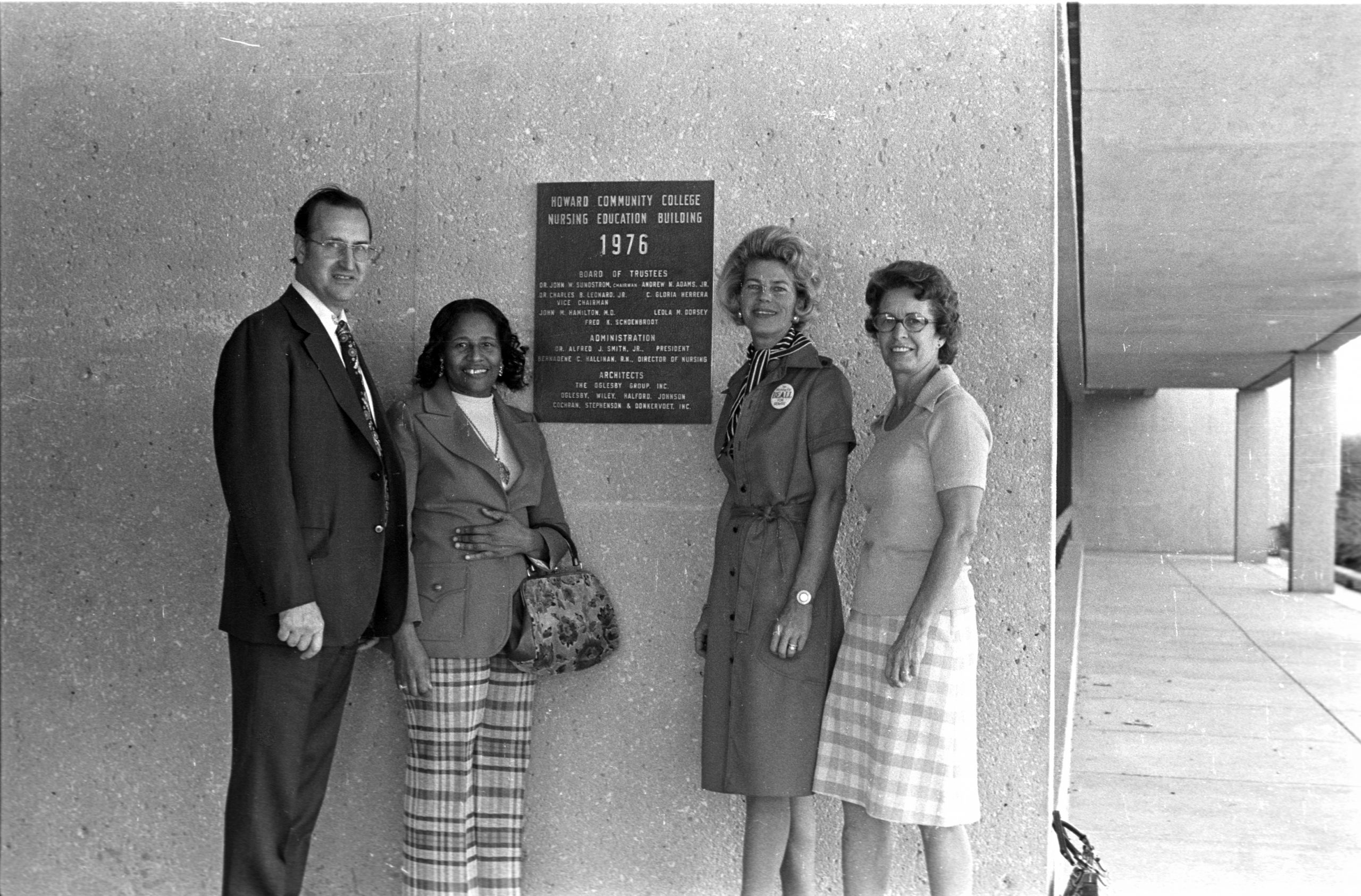
In the spring the Nursing Education Building was finished and a dedication ceremony was conducted on May 2. Some of the dignitaries who attended the ceremony were U.S. Senator J. Glenn Beall, Jr., State Senator James Clark, and Dr. Edward Cochran, the Howard County Executive. The successful nursing program, fully accredited, had its own building now and eight full-time nursing faculty.54 (The reader is invited to examine Appendix IV for a three-dimensional rendering of the Nursing Building as it opened in 1976). The program would continue to be a strong contributor to the nursing profession and, because of its reputation, would be a big draw for students wanting to get nursing degrees.
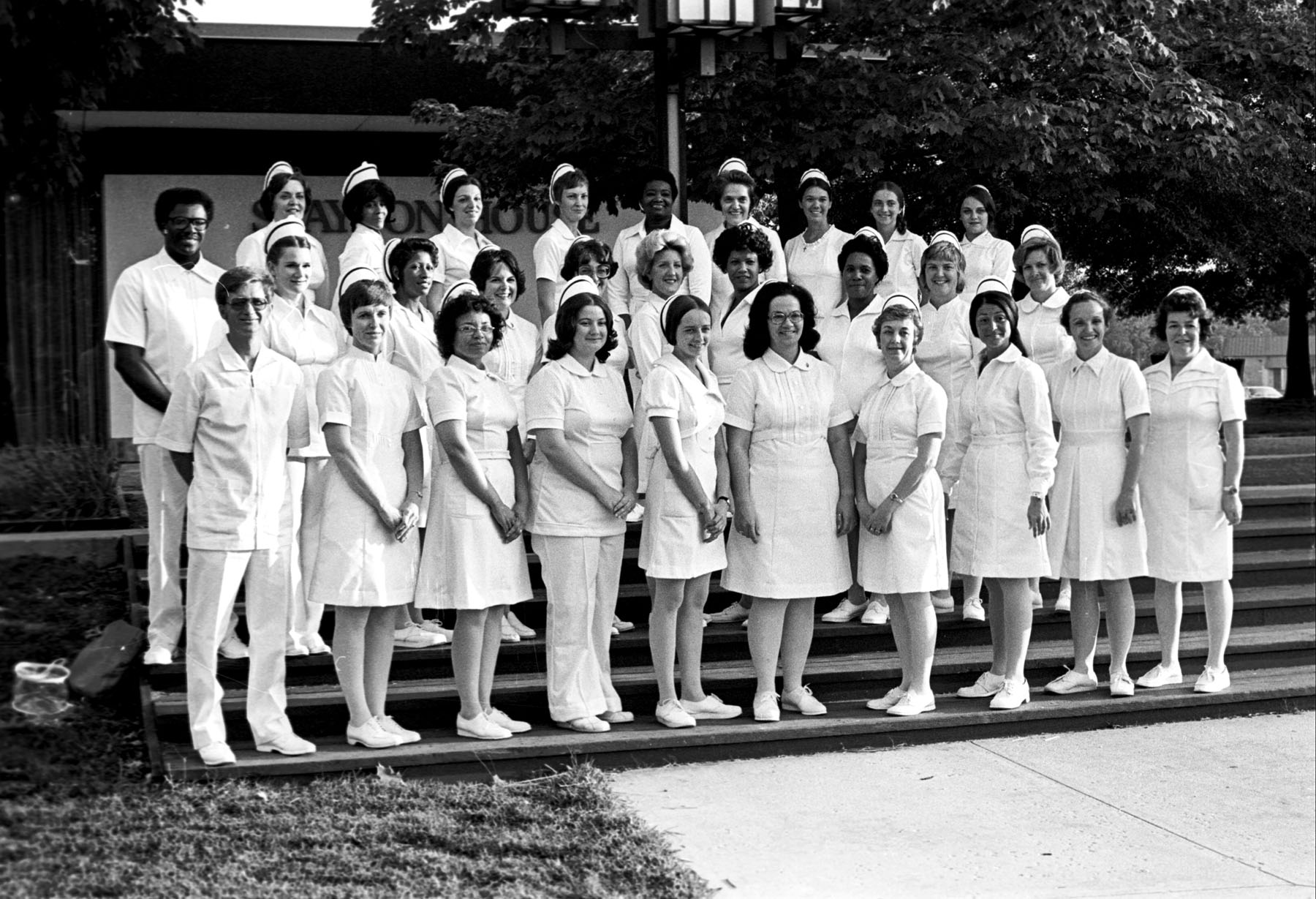
That spring HCC held its fifth commencement and awarded 124 A.A. and 36 certificate degrees.
HCC’s enrollments continued to grow. The 1976 summer session offered 19 day classes and 18 evening classes. Classes began on June 16 and ended on July 28 for day classes and on August 11 for evening offerings. By fall there were 2023 credit students and 2585 credit-free students. In the credit area there were 564 full-time students and 1459 part-time. There were twice as many female students as male; 1339 to 684, and the average age of our students was 28.2! 55 . These ratios and average age would generally stay like this for several years to come. The fall ’76 schedule of classes was printed in tabloid format and was nine pages long. Course descriptions did not precede the section numbers and times; only course numbers and sections were listed. Thus, the nine pages were very compact. There were seven pages of day classes and two of evening classes. With labs included, there were 199 day sections and 76 evening sections offered. 11 Saturday classes and four Educational TV classes were scheduled.
The Secretarial Program expanded to offer Executive Secretarial, Medical, and Legal options as part of its A.A. degree. So, among the degree programs (including the few options) there were now 15 A.A, programs and 10 certificate programs. The college family consisted of 37 full-time faculty, 22 administrators, and 47 support staff. Hammond High School went into operation in the fall of 1976, and Howard County now had seven public high schools that were contributors to HCC’s enrollments. Things were going well.
ENTER THE PRESS
In 1976 the Board of Trustees was a dynamic and diverse group of county residents and contributors to the community and they represented a diversity of professions and occupations, gender, and ethnicity. Andrew Adams was a native Howard Countian who owned and operated a successful landscaping and nursery business. Leola Dorsey was also a native of the county. She had served on the Advisory Committee to the Howard County Board of Education, and she was the first female president of the Howard County NAACP. Dr. John M. Hamilton was a psychiatrist and the Superintendent of Spring Grove Hospital. Gloria Herrera’s background was in nursing and she had served on the original Citizen’s Advisory Committee to the college. Dr. Charles B. Leonard, Jr., a longtime resident of the county, was a university professor of biochemistry and had also served on HCC’s original Citizen’s Advisory Committee. Dr. John Sundstrom, born in Scotland, came to the United States at age 10. His rich background included a Ph.D. from American University, a long career in the U.S. Army from which he retired with the rank of colonel, and memberships on the National Board of Community Colleges and the Maryland State Board of Higher Education.
HCC’s relationship with the press had generally been pretty good. The local and regional press had always covered the college in terms of printing HCC’s press releases, interesting tidbits about new courses, some human interest stories about student successes, faculty accomplishments, and other pieces that kept HCC in the public eye, and most of it was good promotional information about the college. But now came the “however.”
In the summer of 1976 the Howard County Council passed a financial disclosure law requiring “various officials and candidates for local office to make an annual report of their financial interests.”56 The Board was informed that its members fell under that law. Leonard recalls that the Board considered this matter very thoroughly and concluded that the county did not have authority to require such disclosure of the Board. The trustees took the position that they were exempt from this law since the Board “is composed of local citizens appointed by the governor, and they are not paid for their work.” 57 HCC was not alone in this challenge. Quite independently the local election board also challenged this law. Leonard further recalls that the Board was quite firm in its stand to the County Council’s position.58 Both HCC and the Board of Elections Supervisors filed suit for a declaratory judgment exempting them from the financial disclosure law. The judge of the circuit court granted HCC’s Board “the requested suspension of the financial disclosure law for it (sic) pending outcome of the court.”59 Eventually the matter was dropped by the county. However, in the two month period between July 22 and September 23 there were at least 10 newspaper articles dealing with this issue. The press covered it in a fairly detached manner, but in October a different matter literally popped up in the press; really hot on the heels of the financial disclosure dispute.
On October 30 an article appeared in a Frederick, Maryland newspaper that HCC’s president Smith got an $11,000 “unrestricted allowance.” Within a week articles on this topic appeared in the local press of Howard County and Columbia, and in the Baltimore Sun. Following the financial disclosure dispute, another financial issue surfaced. The press smelled blood. Between October 30 and December 30 there were 40 articles on this matter appearing in the local and regional press. And, it cannot be said that the press was entirely objective in this situation. Some of the headlines used the word “secret” when referring to Smith’s allowances. The October 30 issue of the Baltimore Sun headlined its article, “Howard College Head Secretly Gets $11,000.” The Central Maryland News issued an editorial stating that the college should cooperate with the county on an audit, and the November 10 article in the Evening Sun was titled “Cover-up of College Head’s Allowances Denied.”
The County Executive and the County Council had no choice but to get involved and question an “unrestricted allowance.” The issue was that Smith received a housing allowance and an entertainment allowance, and neither was part of his $35,000 salary. Of special concern was the entertainment allowance that he did not have to account for. It was about $3,000. He also had a business expense allocation of $4,000.
Smith and the Board moved quickly. Smith recommended to the Board that his entertainment and business expense allowances be eliminated and be “accessed as vouchers based upon authorized expenditures.” 60 The Baltimore Sun carried an article on November 6 that listed the salaries and benefits of public 2 and 4-year colleges in Maryland and, while salaries and allowances were not standardized, Smith’s salary and benefits were not unusual. Nevertheless, the newspapers continued to pursue the story. The County Executive wanted an audit of HCC’s finances. This, too, was covered in the papers.
After much communication the Board and County Executive agreed on a limited audit. The results of the audit came out at the end of February, 1977. The Howard County Times of February 23, 1977 carried the headline, “College Cleared of Misconduct,” and the Columbia Flier of February 24 stated, “HCC Audit Finds Only Minor Flaws.” Within this entire context of the financial disclosure law dispute and the president’s salary and allowances, a member of the County Council recommended that the Council should have a role in the selection of trustees. Specifically the county should possibly appoint two of the trustees. This recommendation did not go beyond discussion by the Council.
Even when the matter was over, a final shot was taken at Smith. On March 10, 1977, The Columbia Flier ran an article that Smith’s new office had its own kitchen and restroom. By comparison, the Flier reported that when the new county Department of Education building was built, the county’s superintendent of schools would only have a hotplate near his office.
Returning to1976, as it rolled to a close, the Republican-held presidency ended when Jimmy Carter defeated the incumbent president, Gerald Ford, in November of 1976. Governor Marvin Mandel would soon be running into major problems relating to mail fraud and racketeering, and the Equal Rights Amendment was beginning to run out of steam. At HCC, the Dean of the College, Donato, resigned in October to become president of Quinsigamond Community College in Worcester, Massachusetts. He had been looking for a presidency for some time and had been an applicant for the presidency of Chesapeake Community College on the Eastern Shore even about a year before.61 It was no surprise since his track record and interests were in getting a presidency.
There was more to 1976 than administrative challenges and crises. In the academic area interest and concern about general education came to the fore in that year. The Dean of Instruction, Dr. Donald Donato, established a General Education Committee with English Instructor Virginia Kirk as chair. The committee consisted of Thomas DellaTorre (English), Russell Poch (Physics), Dr. Larry Madaras (History), Dr. Robert Schoen (Vision Care), Cynthia Willis (Nursing), James Smith (Associate Dean of Instruction for Career Programs), and Kirk. While the earliest documentation that is available dates to November 1, 1976, its content clearly states that there had been previous meetings of the committee.62 At the November 9 meeting of the committee a general outline of general education skills was developed.
CHANGES IN THE LATE ‘70’s
1977 was a dramatic year. On the world stage Amnesty International won the Nobel Peace Prize. Colleen McCullough’s The Thorn Birds was a best seller, and two famous authors, Anais Nin and Vladimir Nabokov passed away; so did Elvis. However, some popularly known individuals were born that year; the actor Orlando Bloom, the New England Patriots’ quarterback Tom Brady, and the rapper Kanye West. The music groups AC/DC and ABBA were particularly in vogue, as were individual artists Barry Manilow, Donna Summer, and Barbra Streisand. And at the movies, the first “Star Wars” film came out.
The population of Howard County reached 108,000 and Columbia was at 46,000. HCC was moving forward also. As early as January Howard Community College leased space in Chatham Mall on Route 40 to offer Continuing Education classes in real estate and to run small-business workshops. On campus the Physical Education facility was built over and around the locker building that was constructed the same time as the first, and only “main building” in 1970. The cost of the P.E. facility was three million dollars, with the county and state each picking up half the cost. 63 Its opening was without incident; however, about a little over a year before, there was a small amusing construction problem. The height of the P.E. building would be three feet higher than county regulation permitted. But because the college was a state agency it fell within the state’s approval, which it got.
The college continued to contribute educational and cultural programs to the community. In April the college put on a nine week program that focused on the works of the Japanese film director, Akira Kurosawa, probably best known for his famous film, “Rashomon.” Later in 1977 a classic film series was offered, and there was even a four-week credit-free course on the history of the horror movie.
But back in the spring of ’77 the County Executive contacted the college requesting that the college consider contributing about 2½ acres of college property for the construction of the central library of the county. The discussions did not go far however. By May Howard Research and Development Corporation, a joint venture of the Rouse Company and Connecticut General Insurance Company, agreed to donate 2½ acres at the intersection of Little Patuxent Parkway and the South Entrance to Columbia for the central branch. And that is where the library stands today.
That spring administrative change and budgetary issues exploded into a set of conflicts that included the Board, administrators, faculty, students, and the county government. Donato had been gone for several months and Snider was again the Acting Dean of Instruction with Marinich picking up coordinating part-time faculty. A search was under way for a Dean of Instruction. The Dean of Administration, Richard Pettingill had resigned in April, and the Board of Trustees planned for an 11% increase in tuition, going from a $180 per semester for full-time county residents to $200 per semester, and $17 per credit for in-county part-time students, up from $16. Students protested. 64
In May it was known that the County would cut the college’s budget for the following year, and that the cut would be about $345,000. Smith took the position that the college would have to reduce and, in some cases, eliminate programs and personnel. The County Council, however, supported the budget cut which was the county’s share. The Council stated the cuts were not associated with past disputes with the college. They said that HCC could absorb their cut since the state contribution was going from $700 per student to $800.65 Smith disagreed. He identified several offices whose functions would be absorbed into other areas of the college and several individuals would lose their jobs. The anxiety at the college grew and was palpable. There were some meetings during this time at the homes of those affected, and budgetary data were reviewed to determine whether there was any real crisis. The County Council took a very assertive position and wrote “An Open Letter to the Students and Faculty at Howard Community College.” The Council stated that “recent announcements of mass layoffs of staff and faculty are completely irresponsible. The money is there to maintain the staff.”66
On June 9 a quorum of the full-time faculty met and a motion was made and seconded that President Smith be given a vote of confidence and that this vote be delivered to the Board of Trustees. The result of the vote was 9 indicating confidence, 25 indicating no confidence, and one abstention. The results were transmitted to the Board and that same evening each member of the Board lauded Smith and stated their support of him.67
The individuals who lost their jobs as a result of the functional shifts appealed to the Board. The Board “voted to affirm the previous decision made by the Board as recommended by the President with Dr. Leonard abstaining.”68
Students requested to address the Board at the Board’s June 29 meeting. They had a concern over tuition and the potential loss of services. According to the Board’s minutes, the vice president of the SGA presented the students’ appeal and, as a counterpoint, the president’s son, who was a former HCC student, disagreed with the SGA appeal. By the beginning of July most faculty had gone their separate ways for the summer and some of the air had started to clear except for occasional articles in the local papers. One newspaper article noted that the events of the spring at HCC were not so major; however, the article did suggest that the Board and president of the college should be more open. A later article noted that the County was concerned that the Board of Trustees went to a conference in Vancouver, yet college employees had been terminated.69
For nearly the past year the college had been under scrutiny and on the defensive in one way or another. The financial disclosure issue, the president’s allowances, and more recently the budget dispute, retrenchments, and the confidence vote all added up and created a tension within the college and between the college and the county government.70 However, major changes were still in the offing.
In May and June three senior administrators were hired; Edward Harris was employed as Dean of Instruction. He was a Ph.D. from Vanderbilt University and had been Chair of the Languages and Humanities Division at Lorain County Community College in Ohio. To some faculty, and others, he was seen as someone who might bring a more humanistic approach to a college that had become too quantitatively operated and point-oriented. Benay Leff joined the college as Director of Community Information. Fred Nunley came from Dundalk Community College to take over as Dean of Administrative Services. And, in May, the Board hired the Personnel Research & Development Corporation of Maryland, known as PRADCO, “to conduct a study on administrative reorganization.”71 This was not at all surprising. The departure of two deans suggested the benefits of a review and, more importantly, since Donato had been Dean of the College, that position with its authority over academic and student services functions warranted review. Certainly of major importance was the question of the continued relevance of the academic area’s cluster organization. Within a year it would be gone. In retrospect, the cluster organization had had its run. There is no single reason for its demise; rather, a number of factors were at play.
The concept of the cluster organization founded on John Holland’s Self-Directed Search was Donato’s creation, and he implemented it. So, when he left in late 1976 there was no mainstay to keep it going. The Self-Directed Search, as a means and an instrument to assess student interests and capabilities lost out to a new test, the Myers- Briggs Type Indicator. True, the SDS was still used, but Myers-Briggs became more popular and dominant; so, the theoretical foundation for the academic clusters was weakened. The counselors, who were assigned to the clusters, continued to meet, among themselves, as a group fairly regularly to discuss matters of common interest; so, there was an affiliation and a unity there. Some faculty had felt a closer affinity to colleagues within their own discipline than to cluster colleagues who came from other disciplines. And finally, the Associate Dean of Instruction for Student Services did not have his contract renewed, and the new Dean of Instruction (who did not have the title Dean of the College) really had no commitment to the cluster concept. The academic area and student services would change over the next year.
In August, PRADCO issued a report, Study of Administrative Organization. One of the entries stated ”Because of the urgent need to recruit and employ a ‘Chief Administrator for Student Services’ for the College, the PRADCO consultants were asked by the President to focus attention on the Student Services function as a first order of priority and before the completion of the study and submission of the final recommendations.”72
The recommendations for the student services area included all the standard functions which are generally found in many colleges and which are in operation at HCC to this day; although the Computer Center, Cafeteria, and Bookstore were recommended for the Administrative Dean’s area. Counselors would now report to the Dean of Student Services, but would still work with the clusters, would still teach various personal development courses, and would continue to carry faculty rank.
PRADCO specifically made no recommendation about the clusters other than to say that there should be a review between the Dean of Instruction, Cluster Chairs, and Faculty. Credit-Free Instruction should be under the Dean of Instruction, as should the Learning Resources Center. Regarding the instructional developer, PRADCO recommended, “while this position has filled a critical need during the early development years of the College, its very success has probably made it unnecessary for the future.”73 Several months later, in February, 1978, Mizell, clearly having seen the handwriting on the wall, resigned and got employment with NOVA University in Florida. The consequences of all this was that the academic reorganization of faculty into traditional divisions and Mizell’s departure led to a relaxation and diminishing of the systems approach.
In addition to the traditional functions, and the ones mentioned above, the Administrative Dean also picked up one of the functions that the president had carried: construction.
At the September Board meeting PRADCO’s recommendations were approved. The search for a Dean of Student Services went into high gear. The fall semester was under way and some of the tension of the prior spring had dissipated. Rumors and stories that the president had been seriously harmed, and therefore his days were numbered, proved false. At the October 26 Board meeting he received a three-year contract.
’78 ROCKED!
In 1978 the population of Howard County was near 113,000, and Columbia made up 48,000 of the total. Centennial High School was a year into its operation; so, there were now eight public high schools supporting the county and the college. The college’s enrollments were up in all areas. In January the college credit-free enrollment saw 2,200 people enrolled in classes for the winter quarter. This was the largest credit-free enrollment up to that time.74 By that coming fall there would be 2,300 credit students and 2,901 credit-free. The average age of credit students was 29.3. And there was a three-year disparity between the average age of females to males, with females at an average age of 30.3, and males at 27.3. Very few people at the college referred to HCC’s students as “kids.” One would more often hear terms like “adult” student, “returning housewife,” or “Vet.” There also was not much discussed about how unprepared our students were or how high school standards were not what they used to be, as are now frequent topics of discussion.
In January, Walter Bumphus was employed as Dean of Student Services. He had most recently been Dean of Student Affairs at East Arkansas Community College. The senior administrative positions were now all filled. The three Deans were in place, and Benay Leff was Director of Community Information, and Charlene Wenckowski headed up the Institutional Research and Funding Office. There was just one more organizational matter to deal with – the Clusters.
By May the Cluster organization was under review, and by September the reorganization was completed. Harris gave a presentation to the Board and stated that the Clusters were no longer appropriate structures and “decentralization was necessary since the faculty clusters were becoming too large.”75 The result was a discipline-oriented structure headed by Division Chairs. This organizational structure would continue into the mid-1980’s. (See Appendix V for the chart of the organizational structure that was implemented for the academic area).
Throughout 1978 there was continued focus on improving management functions and the supervisory and managerial skills of administrators, including Chairs. The college participated in the Higher Education Management Institute (HEMI). Several HCC employees attended a workshop in Texas whose purpose was to train trainers. Subsequently there were workshops run at the college on fundamentals of supervision and management; however, the system does not seem to have lasted for more than about a year or two.
A number of HCC’s staff contributed their talents and skills beyond the school’s walls. Professor Russ Poch served as a panelist on the National Science Foundation’s Instructional Scientific Equipment Program. His panel reviewed proposals from colleges and universities all over the United States that requested NSF funds. Charlene Wenckowski was a key presenter at the National Conference for Research and Development on methods and techniques of research. And the very popular and admired librarian, Tania Hull, an amateur but very talented photographer, won first place, and $1,000, in the Baltimore Sun’s annual photography competition. Her prize-winning photo was exhibited in the Kodak Photo Gallery in New York City the following year.
Ever mindful of the college’s need to keep its finger on the pulse of the community, the planning and research office conducted a survey of the community’s sense of whether the college was fulfilling the population’s educational needs. The results showed that the college was doing its job, and very well; the curious “however” was that only half the respondents were familiar with HCC’s credit-free program, even though brochures went out to the county residents four times a year.76
By mid-1978 it was clear that greater attention needed to be paid to adjunct faculty. There were about 100 by 1978, most of who had good credentials, but some of whom had not taught before. Those who had were often good natural teachers, but not necessarily experienced in methods and techniques. And HCC was very much into pedagogical theory and methods. In July, Marinich, who was Chair of the Business Division, was also appointed to be Director of Continuing Education. Eventually this title created some confusion, since other schools used this term for credit-free programs, but at the time the college had a Community Education Division headed by Jane Walker, which was the area that was responsible for the credit-free program and educational outreach to businesses. Continuing Education was the function that coordinated credit part-time faculty. This included scheduling evening and Saturday classes, orientation meetings at the start of semesters, maintaining contact with adjuncts, and conducting workshops and other training sessions on developing behavioral objectives, how to construct examinations, grading, dealing with problem students, and whatever else might come up.
As far as the physical growth of the college was concerned, 1978 was a big year. The Communication Arts/Administration Building and the Theatre went up. The Comm/Arts building housed the cafeteria, bookstore, painting, ceramics, sculpture, photography studios, an art gallery, and administrative offices. And, although there were still some construction problems in the theatre that needed resolution, the college hired its first Theatre Director and first Associate Professor of Drama, Mr. Leslie Schimelpfenig. So, by the fall semester Schimelpfenig was teaching theatre courses and was actively communicating with local theatre groups and interested persons about starting a residential theatre group at the college.
At the Board of Trustees level there was discussion, started by Board member Celonia Walden, about establishing an educational foundation. By the October meeting of the Board of Trustees, Charles Reese, the college attorney presented the legal considerations and procedures in establishing such an organization. The Board moved that the attorney “proceed with the legal process of bringing the Educational Foundation into existence.”77 Thus, HCC’s Educational Foundation was born.
The press continued to pay closer attention to Smith than it did in the early years. The events of 1976 and 1977 gave the press a venue for more stories. Local papers had carried stories about Smith’s salary and benefits. So, when Smith’s salary was reviewed in November and he received an increase in salary and housing allowance, The Morning Sun recounted the allowance issue of three years’ past, the vote of confidence of two years’ past, and that Smith was “the controversial president of Howard Community College” and was the highest paid public official in the county.78
AND SO DID ‘79
In 1979 Margaret Thatcher became Prime Minister of the U.K., Mother Teresa won the Nobel Peace Prize, the Soviet Union invaded Afghanistan, and John Wayne died. It was the year in which the population of the county had grown to 116,000 and Columbia was now 50,000 of that. The college’s enrollments continued to grow. That fall HCC would have 2,621 students; 612 full-time and 2,009 part-time. Female students still outnumbered males by 2 to 1.
Jane Walker, who had headed up the Community Education area, and reported directly to the president, had resigned several months earlier to move to another state with her husband. In January Helen Mitchell was appointed Director of Community Education, and Margaret Mohler was appointed Assistant Director. Community Education would now report to the Dean of Instruction, and the various educational outreach efforts and programs for businesses and government agencies would all be part of Community Education. This area was now consolidated under one director and was part of the academic wing of the college.
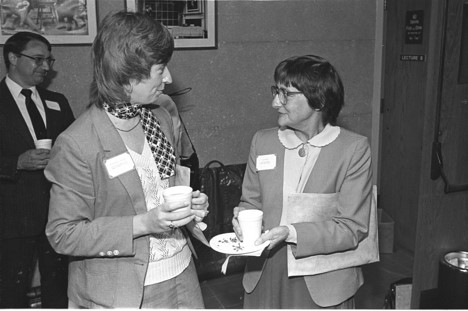
The Physical Education program, housed in its own building, which had opened in February, 1977, offered a number of educational, recreational, and community-oriented services, and really began to hit its stride in ‘78, and even more so in ’79. In general there were four major areas that the existence of a P.E. facility allowed the college to serve. HCC was able to offer credit and credit-free courses and programs as part of its educational mission. The college had moved aggressively into competitive sports when the facility opened, and by ’79 had a number of intercollegiate teams: a bowling team, a basketball team that was ranked 5th in the region, a coed soccer team, a baseball team, and the program fielded its first volleyball team that year. By now the teams were known as the Iron Horse Express. The college put on tournaments: table tennis, volleyball, basketball, and tennis. And finally, and certainly of great importance in making the college a presence in the community, HCC sponsored and supported various athletic events at the gym and on HCC property. County high school wrestling tournaments were held at HCC. The Columbia Association’s aquatic team, “Golden Tide,” used the college pool for their Maryland State Championships. The Soccer Association of Columbia (SAC) used HCC’s fields for their annual Memorial Day Tournament. By 1979 this tournament drew over 1,300 athletes from most mid-Atlantic states and from as far as St. Louis, Canada, and some European countries.
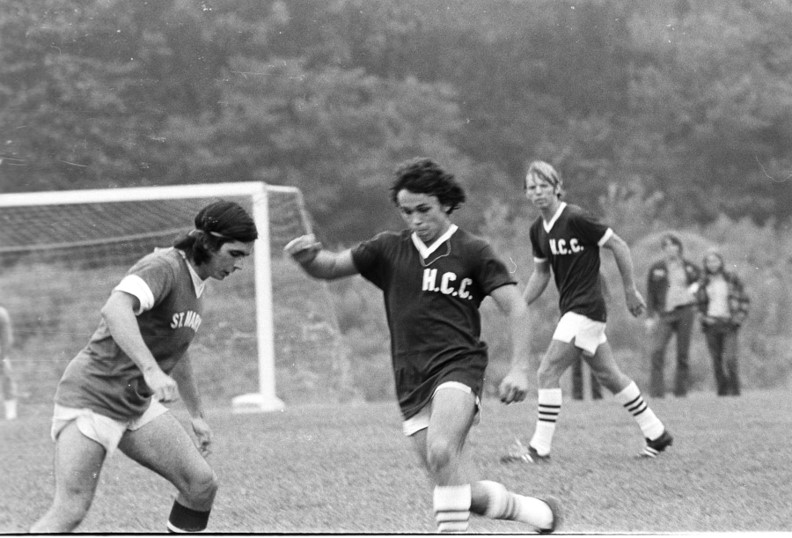
The eighth commencement was held on Sunday, May 20. All graduations were held on a Sunday afternoon, until 1984, when they began to be held on Thursdays. At this graduation the Rev. John Holland of the Full Gospel Tabernacle of Cooksville gave the invocation and the Rev. Richard Tillman of St. John’s Roman Catholic Congregation of Columbia gave the benediction. Invocations and benedictions would continue as parts of commencements into the ‘90’s., but then were discontinued. Representative Beverly Byron was the graduation speaker. She was the widow of Representative Goodloe Byron, and she took his place in the House of Representatives in 1978. There were 206 graduates that year; 170 received their A.A.’s, and 36 earned certificates.
In the academic area the Business Division received a $3,300 grant to study sex stereotyping and bias in business and to develop case studies and role playing scenarios to be used in classes. This was done and, as an additional result of the study, a special topics course was developed on “Women in Management.” There was also educational outreach to the county government. Marinich, who was the Chair of the Business Division at the time, made the acquaintance of the county’s Personnel Director and the two negotiated the college offering after-work courses at the county office building for county employees. Starting in fall 1979 and for the next 2 years, the college offered several business credit courses.
Once again enrollments at the college increased. The fall 1979 headcount was 5,465, with 2,621 credit students and 2,844 credit-free. As before, there were twice as many females in the credit area as there were males, and the average age for females was 30.3 and for males it was 27.2. Tuition went up and began to be calculated differently. There would no longer be a flat amount for full-time students. The new calculation was $18 per credit with $9 for each additional credit over 12. In addition to the regularly scheduled courses Marinich, who was the Chair of the Business Division at the time, had made the acquaintance of the Personnel Director of the Howard County Government, Ms. Janet Haddad, and the two came up with a plan to offer late afternoon credit classes to Howard County government employees. The first course was an Introduction to Business (BU 100) that was scheduled for Wednesdays from 5 to 7:45 P.M. There were 12 students.
Cultural activities increased too. Prof. Lee Hartman of the English Division was able to contact and schedule former Senator Eugene McCarthy to come to HCC and read his poetry. That same month, November, the first theatre production was offered. It was Joseph Heller’s “Catch-22.” In November, the results of a 1978 research study were published in the Columbia Flier. It said, “A survey of 1978 alumni reveals that Howard Community College students graduate with better grade point averages than do community college students statewide and maintain high scholastic averages at the four-year institutions they transfer to.”79 Not a bad way to end the year.
NEARING THE END . . . OF THE BEGINNING
In 1980, HCC’s Educational Foundation was in full swing. The officers were:
Chair Mrs. Celonia Walden
Vice-Chair Mr. Thomas Briscoe
Secretary Dr. Alfred Smith
Treasurer Mr. William Jefferson
While the Foundation did come into being in 1979, much of that time was spent on organizing. By-laws had to be established, committees had to be formed, chairs had to be appointed, goals established, identifying potential donors, and a chair of the fundraising drive had to be appointed. In addition to having this key position in place, the Foundation invited State Senator James Clark to be the Honorary Chairman of the Fund Raising Drive. He accepted.80 Much more detailed work needed to be done, not the least of which were letters of solicitation and a mechanism for prompt “thank you” letters to donors. By January, 1980, the Foundation had received $22,400. The Foundation’s goal had originally been set at $25-50,000 for the first year and $225-250,000 as a five-year goal. In March the Foundation Board changed the five-year goal (to be achieved by 1984) from $250,000 to $500,000.
In March, Robert Matthews, who had been involved with the Fund-Raising drive for several months, resigned. He was moving to another state. He was a long-time resident of the county, and had been Howard County’s Chief of Police.
One of the areas that the Foundation focused on during the year was the creation and promotion of the theatre’s Celebrity Series as a fund raiser. There would be several events; one would be the classically trained actor, Vincent Price, in his one-man show on Oscar Wilde, and there would later be William Windom as James Thurber.
In the instructional area, the Nursing program announced in January, 1980, that it would begin to offer evening nursing courses due to the increased interest of students and the need for more nurses in the healthcare profession. The spring semester also included some new courses; Mark Canfield, HCC’s sociology professor, and Roland Chapdelaine, the biology instructor, offered a team-taught, dual-listed course entitled “Science and Society.” Lee Hartman of the English Division introduced his course on “Creative Writing,” and in the Business Division Management classes were run in both the Spring and Fall for the county government employees. This would continue for several more years.
In March HCC was up for reaccreditation, and a team from Middle States visited the campus from March 9-12. The team was favorably impressed, and the official report came out later that year. In the meantime college life moved on and on Sunday, June 1, the college held its ninth commencement. Of 254 graduates, 215 earned their A.A., degrees and 39 were awarded certificates.
On September 24 the Board of Trustees announced that the college had been reaccredited. The only comment that the team made was “their concern about potential educational effects of decreasing financial support…”81 The fall semester had a credit enrollment of 3,042 students, with 675 full-time and 2367 part-time. The females still outnumbered the males, but not quite by 2 to 1 as before; this time it was 1,992 females to 1050 males. HCC was ten years old.
At the October 22 meeting of the Board of Trustees, Dr. John Hamilton, who was then Chair of the Board, informed his fellow board members that Smith had tendered his resignation effective July 1, 1981. Smith’s notification that he was resigning actually had been given to Hamilton earlier. On October 9 the Columbia Flier devoted an editorial and five pages of its paper to an article entitled “The School Smith Built.” In the article Smith is quoted as saying that “more than a decade of effort has taken its toll on my physical and mental resources. Although I can continue to function…I think it is in my best interests to retire as President at the end of the current year.”82
At that meeting the Board unanimously approved a six month sabbatical leave for Smith, beginning July 1, 1981, and a faculty appointment as Professor of Economics and Business Administration.83 Smith did not, however, return to the college as a member of the faculty following his sabbatical.
The following month a presidential search committee was formed. Its composition included 3 trustees, 2 administrators, 2 full-time faculty, and 2 students. The Board also took the position that since they were not employed by the college they could also represent the community.84 At that same meeting Bernadene Hallinan, the Director of Nursing, and Smith’s wife, tendered her resignation effective June 30, 1981.85 Aside from the personnel discussions of the evening, college financial matters were also covered. The Board was informed that while the college was funded for 1,650 FTE’s, but had achieved 1,685, the Governor of Maryland, Harry Hughes, claiming that there was no additional funding available also went into the detail that stated that no more funds would be available to any community college “from any unused FTE’s by other community colleges”86
1980 had been a year of changes at the college and on a grander scale in the country. The American Olympic hockey team defeated the Soviet team and went on to win the gold medal. At the Moscow Summer Olympics the United States boycotted the games because of the Soviet Union’s invasion of Afghanistan. Four years later the Soviet Union and a number of eastern bloc countries, and Cuba, boycotted the Los Angeles Olympic Games as payback. For those interested in “pop” culture, Jessica Simpson was born in 1980 and John Lennon died that same year. On the political front Ronald Reagan defeated incumbent President Jimmy Carter in November.
The first half of 1981 were Smith’s final six months as president of the college. It was also a time of major changes on the world scene, and moments that shook the world. Ronald Reagan was inaugurated as fortieth President of the United States and less than three months later was shot and seriously wounded by a would-be assassin. In March, Pope John Paul II was shot and seriously wounded by a would-be assassin. That same month Walter Cronkite, CBS Anchorman, retired. And in Atlanta, the Center for Disease Control was homing in on a number of rare infectious occurrences that would, within a year, be identified as Acquired Immune Deficiency Syndrome (AIDS). In the area of popular culture, the reggae musician, Bob Marley, and the rock musician Bill Haley, both died, as did the boxing world’s famous Joe Louis.
At the college, in January, 1981, Smith recommended to the Board that the rank of Professor Emeritus should be established for those faculty who would retire in the future and who had served the college for ten years and had held the rank of Associate or Full Professor, and had made significant contribution to HCC. The Board voted in favor of this recommendation with only one nay vote cast. The minutes of the meeting do not specify the reason for the nay vote.87 Two months later, the first of the theatre’s Celebrity Series was introduced. Vincent Price was on stage in his one-man performance as Oscar Wilde. After allocating and expending a budget of $15,000 on the event, the Foundation still showed a net profit of almost $1,200.88
The spring semester’s enrollments were quite healthy. They were even higher than those of fall 1980. Thus, they were the highest up to that time with a total enrollment of 3,129 credit students; 650 full-time and 2,479 part-time credit students. There were still almost twice as many females as males; 2,029 females to 1,100 males, and the females again were older with average ages of 31.5 for females to 28.3 for males. And the median ages show females at 30 and males at 24.7. Again, HCC students were not “kids.”
While student enrollments in general continued to increase, and some patterns continued, such as male-female ratios, and average age of students, there were some changes. From fall 1974 to spring 1981 the number of Black students (this was the term used at the time), as a percentage of total credit enrollments went down consistently from 13.9% to 8.9%. While the number of Asian students was small, their enrollments between ’74 and spring ’81 went from 6 students to 70; more than a tenfold increase.
At the April meeting of the Board of Trustees, Hallinan, who was the first Director of Nursing and thus had been instrumental in the creation and early growth of the nursing program was the first person to be appointed Professor Emeritus; the appointment to be effective July 1, 1981.89
In May Dr. Dwight A. Burrill was appointed the second president of Howard Community College; the appointment to be effective July 1, 1981. Smith retired the day before. He had been the president of Howard Community College for twelve years.
SMITH’S LEGACY
Smith was a visionary and a trailblazer. His vision that a community college should be an educational institution that was student centered was a firmly ingrained element of his philosophy of education. As he began to put the college together by hiring faculty and administrators, and by allocating resources, he did not swerve from his philosophy. His philosophy translated into trail blazing. During his interviews of applicants for faculty positions both he and his Dean of Faculty made it a point to let some faculty applicants know that courses had to be developed in a way that students would know what learning outcomes they would have to achieve, and this had to be done in a systematic way. The first catalog for the 1970-1971 academic year is instructive in that the various A.A. and certificate programs were called “programs of learning,” and courses were listed as “courses of learning.” While the first several years’ catalogs had courses described in traditional generic terms, such as the introductory business course which said, “An introductory-level course focusing upon the organizational structures and patterns of management existing in American industry. . .”, by 1973 some of the courses in that year’s catalog began to be described in behavioral terms. An example is the Systems Analysis course which stated, “Upon completion of this course you will be able to analyze an organization’s existing procedures by using such analysis tools as data analysis sheets, system flowcharts, process charts, Gantt charts, decision tables, and documents which define system requirements and specifications.”
Programs and courses were added as the needs required. As four-year schools modified their curricula, programs, and standards, HCC kept apace, as it did with the ever changing needs of businesses and industries. Starting in 1969 with a barren field and the beginnings of construction of one building and a locker building instead of a gym, Smith presided over the raising of those facilities and of a nursing education building, an administrative building, theatre, and a physical education facility. This was no small feat. Smith’s personal involvement in overseeing much of the detail of construction and decoration required enormous focus and energy, as did the changes and renovations in existing facilities.
The introduction of summer grants that allowed faculty to develop their courses further, learn new pedagogical methods and techniques, and research student characteristics to improve student learning, moved faculty to the forefront of educational expertise.
During Smith’s tenure resources for faculty development were provided. This included guest speakers, library acquisitions, money for conferences, and workshops on various pedagogical and counseling topics. Some of these workshops were mandatory for faculty. But in spite of occasional complaints about the detail and time commitments that faculty development obligations put on the faculty, in a survey of the teaching staff in 1981, 83% of the faculty queried stated that “if the college placed no expectations upon me to participate in any phase of faculty development, I would still devote about as much time to this area as I do now.”90
The establishment of the Educational Foundation was a major undertaking and a significant addition to HCC’s commitment to promote and encourage education through the granting of scholarships, grants, promoting scholarship, and helping students to realize higher education.
The ultimate success of the college’s first decade can be measured in the growth of the student body over this period. Remembering that several of the adjacent counties’ community colleges had been in operation since the late ‘50’s, HCC’s credit enrollments went from 611 students in 1970 to 3,042 in 1980; so, in that ten year period the credit enrollments increased by 398%. In the credit- free area enrollments in 1970-71 were 1,598, and by 1978 were over 9,000. The growth was 463%.91
The college’s growth, however, was not without moments of anxiety. The first two years, while exciting, witnessed lower enrollments than hoped for and there was concern about the school’s future. The turnover of faculty and administration in those early years, both voluntary and otherwise, added to the anxiety. And the turmoil of the later 1970’s was disquieting. However, as already mentioned, the college grew, successful programs were initiated, physical and financial resources were provided for faculty development and performance, educational and financial resources were provided for students, and the college’s reputation for quality education was established.
Not a bad decade!
APPENDIX I
HCC’S ORIGINAL BUILDING, 1970
FIRST FLOOR
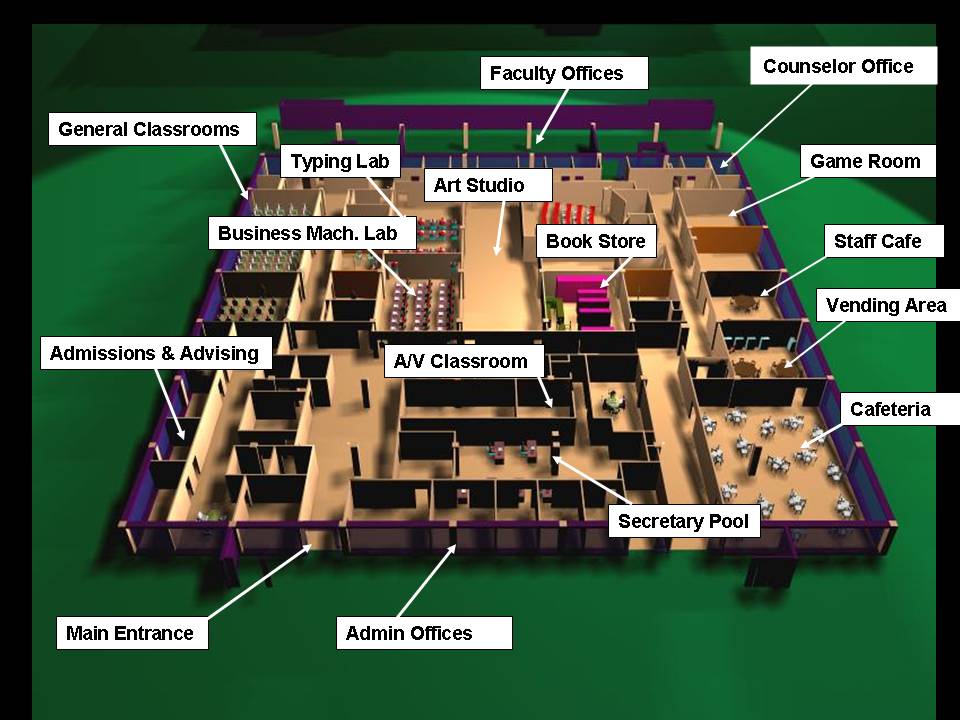
HCC’S ORIGINAL BUILDING, 1970
SECOND FLOOR

APPENDIX II
HCC STAFF WHO WENT ON TO PRESIDENCIES/CHANCELLORSHIPS
Robert Anderson President, Colorado Northwestern Community College
Kenneth Atwater President, Kellogg Community College, Michigan
Walter Bumphus President, Louisiana Community and Technical College System
Roland Chapdelaine President, Cuyahoga Community College, Eastern Campus
Charles Dassance President, Central Florida Community College
Donald Donato President, Quinsigamund Community College, Massachusetts
Myrtle Dorsey Chancellor, Baton Rouge Community College, Louisiana
Frank Gornick Chancellor, West Hills Community College District, California
Ronald Heacock President, Adirondack Community College, New York
Kathleen Hetherington President, Howard Community College, Maryland
Peter Ku Chancellor, Seattle Community College District, Washington
Arnold Maner President, Wor-Wic Community College, Maryland
Lawrence Nespoli President of the New Jersey Council of County Colleges
Charlene Nunley President, Montgomery College, Maryland
This list represents those HCC personnel who went on to presidencies, and does not necessarily reflect these individuals’ current status. Some have retired, others moved on again, and one, Donald Donato, is deceased. It is also possible that there may be individuals who went on to presidencies of whom the author is unaware.
APPENDIX III
CHRONOLOGY OF PUBLIC HIGH SCHOOLS
IN HOWARD COUNTY
1951 Howard High School
1958 Glenelg
1965 Mt. Hebron
1966 Atholton
1971 Wilde Lake
1973 Oakland Mills
1976 Hammond
1977 Centennial
1994 River Hill
1996 Long Reach
2002 Reservoir
2005 Marriotts Ridge
APPENDIX IV
HCC’S NURSING BUILDING, 1976
FIRST FLOOR

HCC’S NURSING BUILDING, 1976
SECOND FLOOR
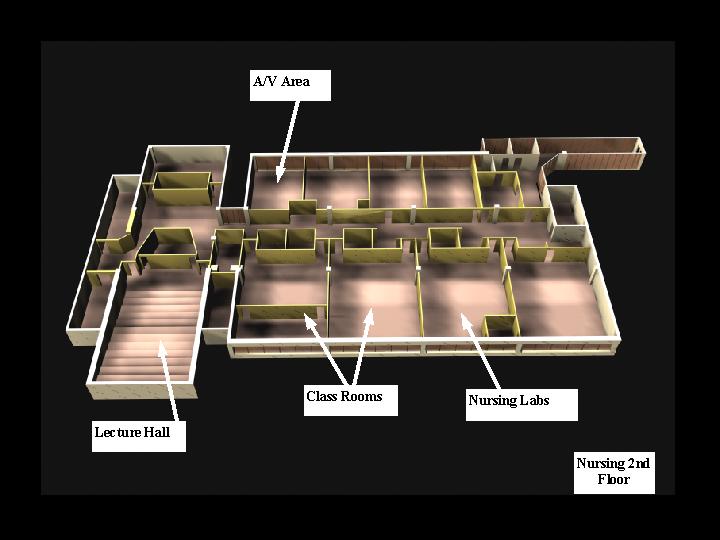
APPENDIX V
This is an exact picture of the organization that was proposed, and adopted, in 1978 to replace the Cluster model
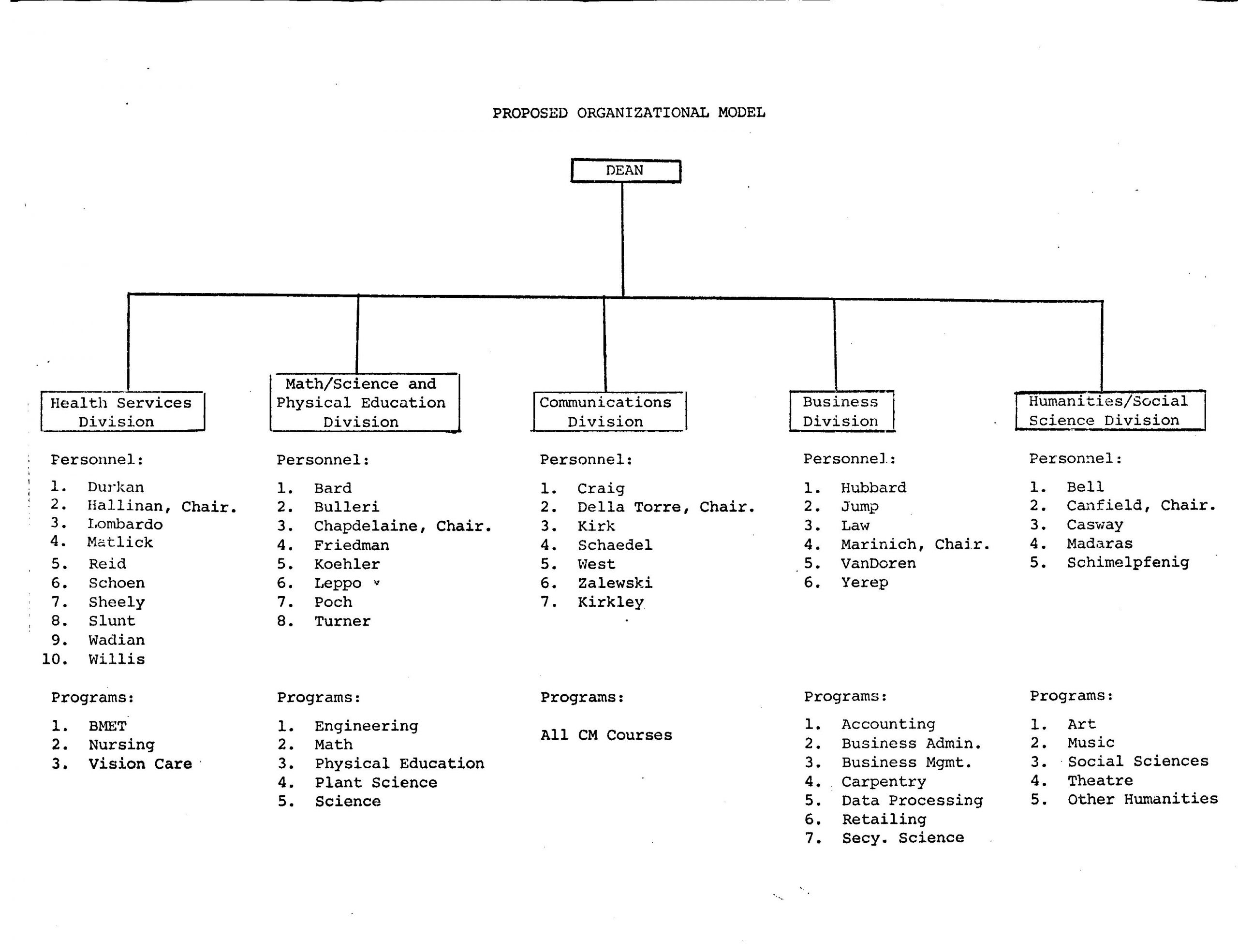 APPENDIX VI
APPENDIX VI
| HCC CREDIT ENROLLMENT | 1970 | 1971 | 1972 | 1973 | 1974 | 1975 | 1976 | 1977 | 1978 | 1979 | 1980 |
| Full Time | 248 | 337 | 317 | 416 | 429 | 542 | 564 | 601 | 601 | 612 | 675 |
| Part-Time | 363 | 390 | 620 | 917 | 1030 | 1426 | 1459 | 1628 | 1786 | 2009 | 2367 |
| Total Students | 611 | 718 | 937 | 1333 | 1459 | 1968 | 2023 | 2229 | 2387 | 2621 | 3042 |
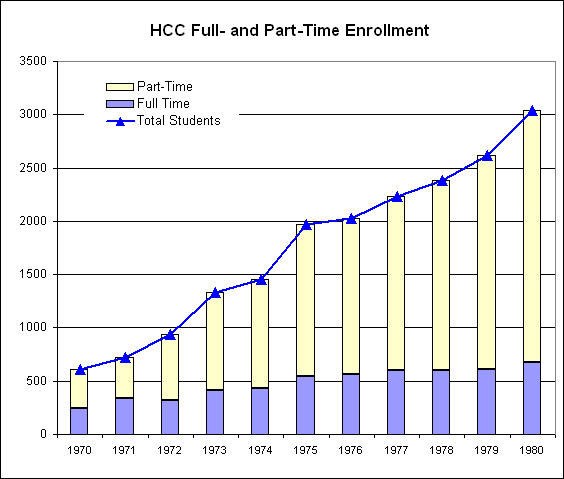
ENDNOTES
[1]www.columbia-md.com/columbiahistory.
[2] Agenda for College Advisory Group, Columbia Archives, undated.
[3] James Rouse, “Potentials for a College in Columbia”, Columbia Archives, undated.
[4] Idem.
[5] Idem.
[6]L. Madaras interview with Dr. Edward Cochran, June 4, 2003.
[7] Idem.
[8] Idem.
[9] Idem.
[10] Idem.
[11]Dr. Edward Cochran at the 35th Anniversary Panel Discussion, November 11, 2005.
[12]“Board Formalizes Plans to Buy College Site,” Central Maryland News, June 23, 1966.
[13] Board of Trustees Minutes, May 6, 1968.
[14] The Morning Sun, Tuesday, November 12, 1968
[15] The Howard County Times, June 26, 1969.
[16] The Village Voice, November 1969
[17] Ellicott City Times, March 2, 1970.
[18] Central Maryland News, August 17, 1970, pp. 2, 6a.
[19] Likins, Jeanne. “A Stepping Stone: The History of Anne Arundel Community College.” Ph.D. Dissertation, American University, 1981.
[20] “Professional College Staff Biographies,” undated, but ca. 1970.
[21] Smith, Philosophy and Role of Howard Community College, August 26, 1970.
[22] Idem.
[23] Idem.
[24] Idem.
[25] Madaras interview with Dr. James Bell, June 24, 2002.
[26] Marinich interview with Virginia Kirk, March 28, 2006.
[27] Promises to Keep. New York: Houghton Mifflin, 1999, p. 336.
[28] Minutes of the Organizational Meeting of the Howard Community College Faculty Association, March
24, 1971.
[29] Forsythe letter to Kirkley, March 24, 1971. Madaras interview with Kirkley, May 29, 2003.
[30] Smith. Op. cit., p.7.
[31] L. Madaras interview with R. Levene, June 2004
[32] Note, A. J. Smith to Marinich, May 2006.
[33] Tabloid, December 20, 1971, p.1.
[34] Memo, Donald G. Forsythe to All Faculty, March 1, 1972.
[35] Faculty Management/Evaluation System, September 1, 1976, p. II-85b.
[36] Memo, Donato to Workshop Participants, August 24, 1972
[37] Columbia Flier, December 6, 1972, p. 18.
[38] Columbia Flier, December 13, 1972, p. 9.
[39] Columbia Flier, July 11, 1973.
[40] Self Evaluation, Howard Community College, July 1974, p. 185.
[41] Memo, Donato to Cluster Chairs, October 8, 1973,
[42] Marinich interview with Kirk, March 28, 2006
[43] Report of the Middle States Association, undated but received by the Dean of Instruction, December 13, 1974.
[44] Board of Trustees Minutes, January 16, 1975.
[45] Memo, Donato to Faculty, November 1, 1974.
[46] Howard County Times, December 11, 1974.
[47] Marinich phone interview with Dr. Harvey, April 25, 2006.
[48] Marinich memo to Dean Donato, December 23, 1975.
[49] J.S. Smith memo to Dean Donato, December 30, 1975.
[50] A.M. Zalewski memo to Dean Donato, December 19, 1975.
[51] Board of Trustees Minutes, November 13, 1975.
[52] Madaras interview with H. Mitchell, June 15, 2004.
[53] HCC 1975-1976 Catalog, p. 49.
[54] HCC Catalog, 1976-1977.
[55] Mini-Profile of HCC Enrollment, Fall, 1976.
[56] Columbia Flier, July 22, 1976, p. 10.
[57] Ibid., p. 13.
[58] Marinich interview with Dr. Leonard, June 21, 2006.
[59] Howard County Times, September 22, 1976.
[60] Board of Trustees Minutes, November 10, 1976.
[61] Board of Trustees Minutes, November 13, 1975.
[62] Memo from V. Kirk to Dean Donald Donato, November 1, 1976.
[63] Baltimore Sun, January 16, 1977.
[64] Columbia Flier, May 5, 1977.
[65] Columbia Flier, June 2, 1977.
[66] County Council of Howard County, “An Open Letter To The Students and Faculty at Howard Community College, June 8, 1977
[67] Board of Trustees Minutes, June 9, 1977.
[68] Board of Trustees Minutes, June 14, 1977
[69] Columbia Flier, October 13, 1977.
[70] In retrospect, a few individuals who were at the college at the time of the confidence vote, Marinich included, felt that the majority of the faculty were reacting as much to the years that they operated under the point-oriented Faculty Evaluation System and Donato’s management style as they were to Smith.
[71] Board of Trustees Minutes, May 19, 1977.
[72] Op. cit, p. 5.
[73] Ibid., p. 13.
[74] Howard County Times, January 25, 1978, p. 8a.
[75] Board of Trustees Minutes, September 27, 1978.
[76] Howard County Times, July 19, 1978.
[77] Board of Trustees Minutes, October 25, 1978.
[78] December 12, 1979.
[79] Columbia Flier, November 1, 1979.
[80] Minutes, HCC Educational Foundation, September 20, 1979.
[81] Board of Trustee Minutes, September 24, 1980.
[82] Columbia Flier, October 9, 1980, p.20
[83] Board of Trustee Minutes, October 22, 1980
[84] Board of Trustees Minutes, November 19, 1980
[85] In a television interview Hallinan stated that it was difficult to keep roles separate. Smith was the president of the college, Hallinan was the director of the nursing program, and they were married. Given this difficulty, they decided to retire at the same time.
[86] Idem.
[87] Board of Trustees Minutes, January 28, 1981.
[88] HCC Educational Foundation Minutes, June 18, 1981
[89] Board of Trustees Minutes, April 22, 1.
[90] Howard Community College Faculty Development Report, 1980-1981, p. 121.
[91] “Analysis of Credit-Free Enrollments,” Miscellaneous Internal Reports, 1977-78.
